

Everyone relies on them to explain and advise about important social and moral trends, but in faculties dominated by political correctness are our social scientists afraid of the Truth, or of offending sensibilities, or...



Everyone relies on them to explain and advise about important social and moral trends, but in faculties dominated by political correctness are our social scientists afraid of the Truth, or of offending sensibilities, or...





the Parish. the Nation. the World.
The plight of 50 children kidnapped from a Thai orphanage last December almost certainly for sex trafficking, is winning increasing attention at the highest levels in Australia
 BY BRIDGET SPINKS
BY BRIDGET SPINKS
THE FEARED abduction of 50 children from a Perth-funded orphanage on the ThaiMyanmar border for child sex-trafficking in December last year has now been raised in Federal Parliament.
In the House of Representatives, Federal Member for Pearce, Judi Moylan, called for tightening of the Sexual Offences Against Children Bill 2010, highlighting the plight of the missing children from the Sang Khan Buri orphanage aged 10 to 14 on 28 December 2009.
“The Bill introduces new offences for Australians, both citizens and residents, dealing in child pornography and abuse material overseas,” Mrs Moylan told Federal Parliament on 9 March.
“Such abhorrent behaviour is intolerable and illegal for Australians in Australia and should, and now will, be illegal Please turn to Page 8
“Be indefatigable in your purpose and with undaunted spirit resist iniquity and try to conquer evil with good, having before your eyes the reward of those who combat for Christ.”
-Bishop Matthew Gibney 1874
A third volume of Blessed Mary MacKillop’s letters just published by her Order reveals the homesickness, illness and even arguments experienced by her Sisters when establishing the congregation in New Zealand up until her death in 1909.
Mary MacKillop on a mission - to her last breath, published by the Sisters of St Joseph of the Sacred Heart congregation which the nun co-founded in South Australia in 1866, showed her as a “warm human being, a trusted friend and a figure of authority who stands up to others when necessary”, said the book’s editor Sr
Sheila McCreanor, the Order’s secretary general. It was launched on 12 March at Mary MacKillop Place in North Sydney, the congregation’s headquarters where Blessed MacKillop – whom Pope Benedict XVI will canonise in Rome on 17 October - was based from 1883 when Bishop Christopher Reynolds of Adelaide established a commission of inquiry into her Order.
In an interview on 12 March with The Record, Sr McCreanor said it was “particularly inspiring” how she continued to write to her sisters in New Zealand to reassure and foster leadership in them despite her own sufferings – both physical and emotional from the Please turn to Page 3
Western Australia’s award-winning Catholic newspaper since 1874 - Wednesday, 17 March 2009 Perth, Western Australia $2 www.therecord.com.au

VATICAN CITY - Priests today are challenged with the task of drawing the faithful back to Confession and assuring them that their true repentance will be met with mercy and compassion, Pope Benedict XVI said.
In an address to several hundred young priests, Pope Benedict said on 11 March that “we must return to the confessional” not only as a place to confess sins and receive absolution, but also as a place where “the faithful can find mercy, counsel and comfort, feel loved and understood by God”.

by the Apostolic Penitentiary, a Vatican court that handles issues related to the Sacrament of Penance.
lives.” This mentality makes it difficult to “distinguish good from evil and develop a proper sense of sin.”


The Pope addressed some 700 priests at the conclusion of an 8-12 March course designed to develop their skills as confessors; the course was offered

Bibiana
Caroline
Priests are called on to educate their flocks in the “radical requirements of the Gospel” and help them resist “the mentality of this world” and make choices that take courage and are sometimes unpopular, the Pope told the group.
The times are difficult, he said, and marked by “a hedonistic and relativistic mentality that cancels God from people’s
Priests must be particularly good examples in their lives so that Catholics will understand their own sins and find the courage and desire to seek God’s forgiveness, he said. During the course, Archbishop Gianfranco Girotti, regent of the Apostolic Penitentiary, spoke to the priests about the challenges and the complex situations that confessors are required to handle. He reminded them that the Church seeks to help “even in situations that are humanly so difficult that they seem to have no solution.”

Among these situations is the plight of divorced Catholics who, if they remarry, are no longer allowed to take Communion.









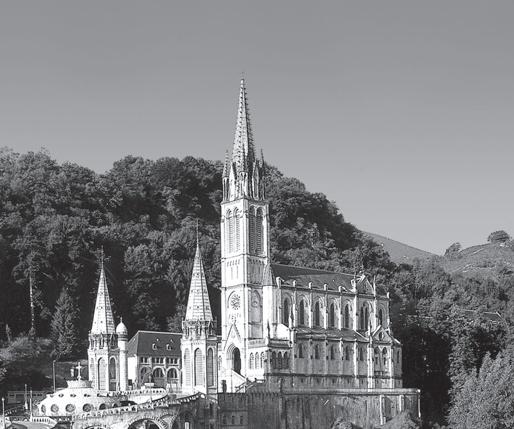

A 15 day pilgrimage
Departing 29 July 2010
Lisbon • Fatima
Anniversary • Avila • Burgos • Garabandal • Loyola • Lourdes
+ OBERAMMERGAU OPTION
Also Departing: 9 May • 9 Jun • 9 Sep
• 9 Oct 2010
• Optional 9 night Holy
Land or 9 night France extension


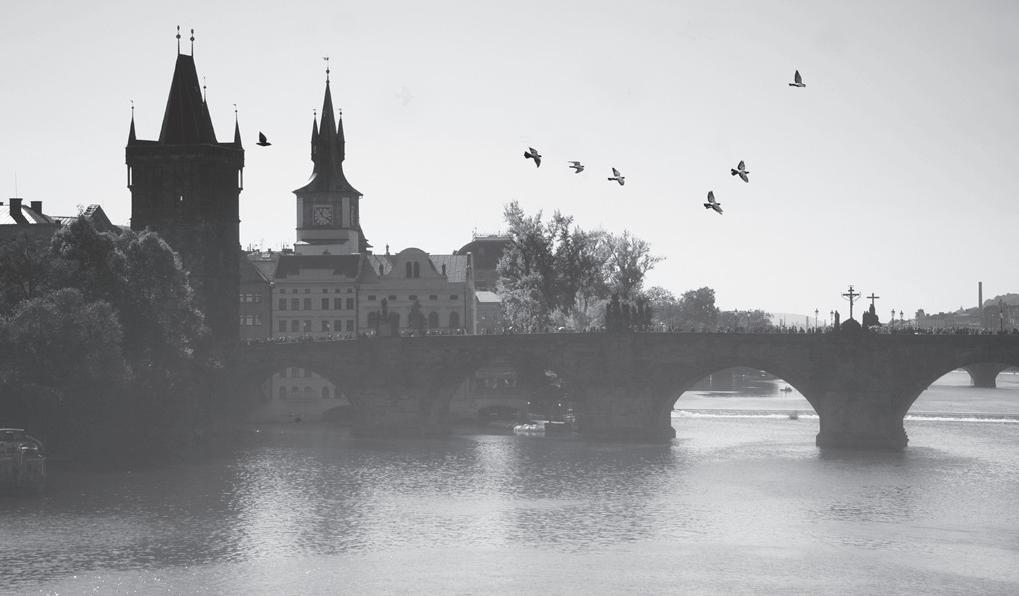






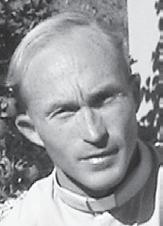
Archbishop Girotti said that in those cases, if the person cannot separate from the new spouse for various reasons, the confessor could suggest that refraining from sex and transforming the relationship into one of friendship might open the way to the possibility of partaking once again in Communion.
He also said confessors must be careful with the psychological states of penitents; if they find themselves with someone with serious problems they should not “try to be a psychologist,” but rather seek expert help.
Archbishop Girotti warned that in the case of repeat offenders, who don’t show even a minimal intention to change, absolution must not be granted.
However, the priest must be very patient because a conversion is always possible, he said. Showing that there is a better way to live is always the job of a priest, especially as an antidote to increasing hedonism and selfishness in contemporary society, said Archbishop Fortunato Baldelli, who heads the tribunal as major penitentiary.
“It’s the duty of the confessor to open the consciences of people and make them understand the needs of others, showing them that doing so won’t take anything away from them, but will make them richer.”
Youth urged to grow in faith in Pope’s WYD message
VATICAN CITY (CNS) - Pope Benedict XVI urged young people to follow their dreams, dedicate their talents to the common good, and grow in love and faith.
The Pope told the world’s young Catholics to not let life’s difficulties lead to discouragement.
“Instead nurture in your heart great hopes for fraternity, justice and peace. The future is in the hands of those who know how to seek and find strong convictions in life and hope,” he said in his message for World Youth Day 2010.
The Vatican and most dioceses around the world will mark WYD on Palm 28 March. In his message, released in Italian and French by the Vatican on 15 March, the Pope asked young people to build a more just and fair world.
Changing the world for the better does not have to mean “performing heroic or extraordinary acts, but allowing your talents and potential to bear fruit and committing yourself to constantly growing in faith and love,” he said.
The theme the Pope chose for the 2010 celebration was from Jesus’ encounter with the rich young man in St Mark’s Gospel: Good teacher, what must I do to
inherit eternal life? Pope Benedict noted that 2010 marks the 25th anniversary of the institution of World Youth Day, which he called “a prophetic initiative that has brought abundant fruits.”
In his message he told young people to not be afraid of confronting difficult questions about life such as: What makes life a success, and what gives meaning to life?
“Such questions need real answers that will fulfill “your authentic expectations for life and happiness,” he said.
The answers will come from listening to God, who has a loving plan for each and every person on earth, he added.
VATICAN CITY - The Catholic Church remains the same throughout history despite new movements and reforms frequently arising, Pope Benedict XVI said at his public audience on 10 March.
The Second Vatican Council’s renewal of the Catholic Church was a sign of progress, not a sign of repudiating the past, Pope Benedict XVI said.
“We know that after the Second Vatican Council some people were convinced that everything was new, that there was a new Church, that the pre-conciliar Church was finished and that we would have a completely different Church,” the Pope said.
Their vision would have led to “a utopian anarchy,” he said, but the wise guidance of Pope Paul VI and Pope John Paul II “defended the new things brought by the council, while affirming the oneness and continuity of the Church”.
The Pope made his remarks about reactions to the Second Vatican Council during an audience talk focused on St Bonaventure’s attempts in the mid-1200s to balance enthusiasm for the new form of religious life introduced by St Francis of Assisi with continued fidelity to the hierarchical Church.
St Bonaventure taught the early Franciscans and continues to teach Catholics today that living the faith requires “discernment, sober realism and openness to new gifts” given to the Church by the Holy Spirit, the Pope said.
St Bonaventure was superior of the Franciscans at a time when a large group of friars embraced the teaching of Joachim of Fiore, who taught that history followed a “Trinitarian rhythm,” in which
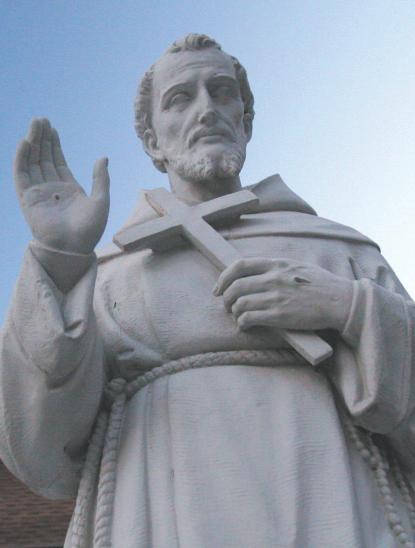
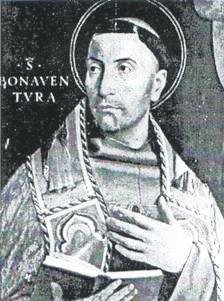
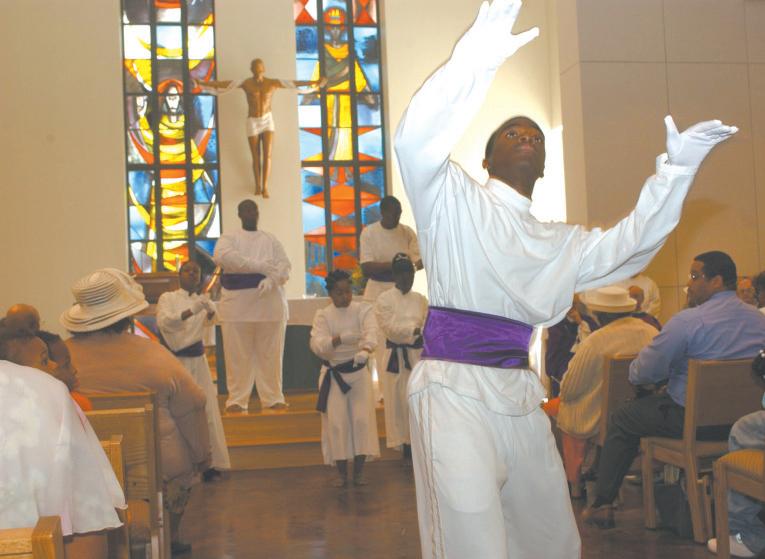
the Old Testament age was the time of God the father, a time of severity; the New Testament and the first millennium of the Church was the time of Jesus Christ and the “relative freedom” that came from no longer being bound to many of the Jewish laws; and the age of the Holy Spirit was to be a time “of complete freedom,” Pope Benedict said.
The group of Franciscans who saw St Francis as initiating the age of the Holy Spirit believed it would be a time when “the hierarchical Church was left behind in order to give birth to the new Church of the Holy Spirit, no longer tied to the old structures,” the Pope said.
“There was, therefore, a risk of a very serious misunderstanding of St Francis’ message and of his humble fidelity to the Gospel and to the Church,” the Pope said.
After studying Joachim of Fiore in depth, St Bonaventure presented his own theology of history, affirming that history is a progressive movement, but that it is directed by God, who is one and who has fully revealed Himself to
humanity in Jesus Christ, the Pope said.
The Gospel is God’s final revelation to humanity and the Church is where God wants people to live their faith, the Pope said.
“This does not mean that the Church is immobile, fixed in the past and that there can never be anything new in it,” the Pope said, because as St Bonaventure taught, “the works of Christ do not go backward, but progress.”
Greeting English speakers at the audience, Pope Benedict spoke of the “promising sign of hope” coming from the Northern Ireland Assembly’s vote on 9 March to move oversight of the police and of the courts from Great Britain to Northern Ireland, furthering the process toward full local governance. He said he prayed the move would “help consolidate the future of peace desired by all.”
At the end of the audience, the Pope also expressed his condolences to the people of eastern Turkey where an earthquake on 8 March left more than 50 people dead and thousands homeless.
Continued from Page 1 persecution she received from clergy and Bishops.
Her physical pain would have been due to the fact that she was “constantly on the go,” often in very cold conditions, said Sr McCreanor, who is also a sociologist and educator. Blessed MacKillop made four visits to New Zealand that are mentioned in the new book – “which is no mean feat considering they travelled by steam boat, and by horse and carriage or trains across land”, Sr McCreanor said.
“They wouldn’t have had good food. They were as poor as the people they were working among, so they had to make do with what was available; medical assistance wasn’t as great as now, so people did what they could to cope,” Sr McCreanor said.
Blessed MacKillop suffered a stroke in 1902, after which time she “could not walk much”, Sr McCreanor said, and gained weight significantly, as photos from her later years reveal in the book.
She experienced significant menstrual pain, rheumatism, and what Sr McCreanor suspects may have been undiagnosed Multiple Sclerosis or Parkinson’s disease judging by the ailments detailed thoroughly in her letters.
“She tried to keep up contact
with her sisters, whose numbers were always growing, but it came at a personal cost to herself,” Sr McCreanor said.
However, a letter from a Dr James Isbister to Sr La Merci Mahony dated 20 March 1905 revealed Blessed MacKillop was dealing well with her ailments.
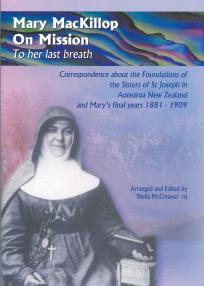
“Considering the original nature of the disease, she is now remarkably well both bodily and mentally. The paralysis of the arm and the weakened power of the leg are both permanent and will not improve. Her mental condition is quite clear and there is no trace of blurring of her intellectual faculties - these are as bright as ever,” the doctor said.
“It is remarkable how clear and concise is her train of thought. At times she is emotional. There is always the possibility of another haemorrhage in the brain and this is ever present. Excitement and worry are not good for her.”
After New Zealand missionary Marist Fr Louis Fauvel wrote to Blessed MacKillop many times “begging” her to send him sisters to help educate the local poor children in Temuka in New Zealand’s
South Island, Bishop Reynolds sent three sisters from Adelaide. They were to be led by Sr Calasanctius Howley, whom Reynolds deemed “particularly troublesome” as she had been a staunch supporter of Mary in her difficulties with the Bishop, said Sr McCreanor.
Blessed MacKillop also had to “dispel gossip” amongst her sisters in New Zealand, Sr McCreanor said, as sisters were spreading rumours that she had not re-appointed Sr Raymond Smyth as Provincial after a leadership meeting in Sydney.
In a letter to Sr Raymond dated 9 December 1896, Blessed MacKillop said: “Have you really made up your mind not to write to me, and can it be that you are influenced by an unworthy motive, such as ‘Mother Mary did not wish me to return here as Provincial’.
“Oh Sister, even if it were true, I thought too highly of you to think you capable of resenting that. You were the very last I thought capable of seeking high office … Be your feelings towards me as they may, I regard you as my Sister and loved child, and write now to wish you all and your community a very happy Xmas.”
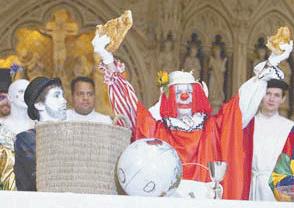
The Mazenod College community in Lesmurdie in Perth’s hills raised $4 million for a new multi-purpose building, which was opened and blessed by Oblate of Mary Immaculate Provincial Fr Harry Dyer on 5 March.
With no State or Federal Government building grants available, it was left to the school to raise the money needed to build the 10 classrooms, one computer lab, a uniform shop, five new offices for Heads of Year, VET (Vocational Education and Training) and careers counsellors, school psychologists and special education teachers.
For the first time in 30 years, Mazenod College in Lesmurdie had an intake of 140 Year 7 students this year, which necessitated the construction of more classrooms. The building started in October 2008 and finished in January this year in time for the start of the new school year.
While it was built predominantly for Year 11 and 12 students, it is used by all year levels.
The project’s financial director Eric Paini said the Shire of Kalamunda also assisted the school in meeting “some very tight deadlines”.
The architect was Grant Adams of Saleeba Adams and it was built by Pinda Constructions.
The blessing by Fr Dyer consisted of prayers and sprinkling with holy water, as it is tradition to bless new school buildings.
Also present to mark the day were Oblate Fathers Michael Twigg, Rector of Mazenod College in Victoria, Michael McMahon, John Cranley, former University of Notre Dame Australia chaplain Gerard Conlan, Donal Madigan, Tony Maher and Lewy Keelty. College chaplain Justin Hillard and school vice captains Adam Reeves and Tom Gubbins from Mazenond College in Victoria were also present.
The 2010 WA State Education Census population of Mazenod College is 770 students. Year 11 and 12 students combined number 225.
Mazenod College was founded by the Oblates of Mary Immaculate 40 years ago.
Christian Brother who devoted his life to education returns to his beloved creator
BY GLYNNIS GRAINGERA CHRISTIAN Brother who devoted his life to education as a teacher and a learner for more than 50 years died on 16 February at Wembley.
Br John Patrick Marks, born on 21 March 1935 at Naracoorte, South Australia, taught at Aquinas College, Manning from 1967, and became deputy principal in the mid1970s.
He was an outstanding teacher of physics and maths and coached cricket and football teams, plus managed debating teams.
He is best remembered in South Australia, perhaps by thousands of students and their families, for when he was principal of Rostrevor College and later of Christian Brothers College, Adelaide.
The son of John Marks Snr and Joan (nee Kelly), John attended six primary and four secondary schools, such were the variety of places his father was sent to as a postal officer, including Port Augusta. He attended Rostrevor College as a student for only two years but that did not prevent him from being head prefect and dux in 1952.
Br John’s paternal grandfather was taught by Mary MacKillop and his maternal grandfather worked in Paris with Louis Pasteur –perhaps links to John’s dedication to Catholic education and abilities in science.
Br John gained a comprehensive list of university qualifications, including a Bachelor of Science and Bachelor of Education from Melbourne University, a Master of Educational Administration from Flinders University and a Master of Counselling from the University of Notre Dame in Fremantle; this last one completed when he was 65.
There was a ministry focus to his studies, not the quest to accumulate degrees.
He entered the Christian Brothers in April 1953, made his first vows in March 1955 and final vows in December 1960.
His early service was with communities

and missions at Box Hill (1956) and St Kilda (1959) in Victoria.
Back in South Australia, John Marks was principal of Rostrevor College from 19771983 and of CBC Adelaide from 1986-1994.
CBC remembers him as “a man of faith, compassion, wisdom and excellence; a life dedicated to the service of God through education”.
Br John was a very active member of the South Australian and Western Australian Commissions for Catholic Schools.
Dr Wayne Tinsey, executive director of Edmund Rice Education, Australia, said Br John was one of the giants of Christian Brothers’ education in Australia.
He showed a passionate concern for the marginalised and the underdog.
But he also had a sense of fun and a clever practical joke on a friend was not beyond him. Br John had a sabbatical in 1995 but back in WA he resumed work in leadership and in helping younger people before spending his final time at the Christian Brothers’ community’s Edmund House in Wembley, WA, with cancer.
He was taken to God just short of his 75th birthday.




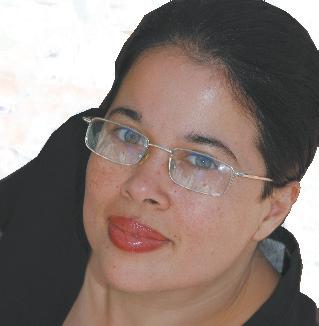
I HAD a conversion experience on 13 May 1987. It took place through a miraculous medal of Our Lady in a jewellery store. Suddenly all the jewellery disappeared from my sight in the window display and all that was left was this miraculous medal.
A mystical experience, one might say. Inspired and compelled to buy it, I began wearing it. As a result, it changed my life which ultimately led to my entrance into the priesthood. After this event, I had a profound awareness that I had to pray the Rosary every day, wear the brown scapular and consecrate myself to Our Lady. The more I prayed to her the more she took me to her son Jesus Christ and His Catholic Church. The motto I have taken for my priesthood is: Omnes cum Petro ad Jesus per Miriam which means “All with Peter to Jesus through Mary.”
Mary’s role is to bear Jesus to us and us to Jesus. His role is to bear us to the Father for He said, “I am the way, the truth and the life. No one comes to the Father except through me” [John 14:6].
My prayer life consists of the daily celebration of the Mass. Again, upon this extraordinary experience back in 1987, I was given an infused understanding of the Sacrificial and Sacramental nature of the Mass. I also pray the Divine Office of the Church, a Holy Hour, three Rosaries in keeping with Our Lady’s maternal request at Fatima and the Divine Mercy Chaplet every day.
Through Divine Providence, I met Mother Teresa in Ireland. She singled me out in a vast crowd, embraced me and promised to pray that I become a holy priest.
I was graced to have a conversation with her. She took my hand and placed in it a miraculous medal which subsequently
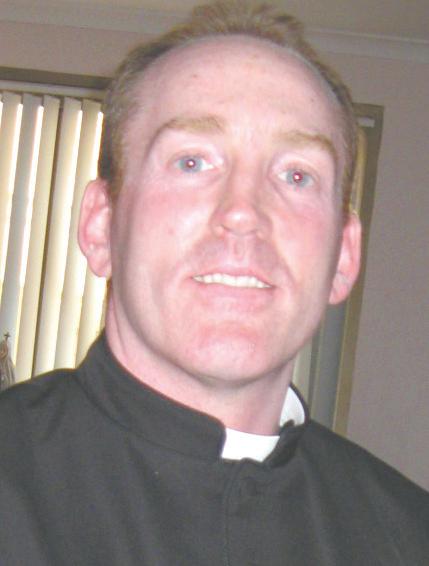
I gave to my mother. As for myself, I am assured of a powerful intercessor in Blessed Teresa of Calcutta.
I have also been graced with a wonderful family who reside in Dublin. My brother Barry is of saintly stock as he has a mental handicap. I remember one midnight I was leaving to make a Holy Hour in the local Church when suddenly I heard a voice telling me to go back into the house. I then decided to make a spiritual hour at home before an image of Our Lady. During that hour I was inspired to go upstairs to get a book in my room. As I was going into my room I heard another voice audibly telling me to go into Barry’s room to have a look at him.
There, I found him in bed with a cigarette lighter in his hand and the whole top bunk blazing on fire above him.
I believe that God brought me back to the house that night to save him and perhaps my whole family.
Faith is a beautiful gift, the pearl of great price. It is a pearl that Our Lady so graciously obtained for me through her intercession and a pearl worth giving everything up for - even one’s own life. I believe the great crisis of faith today is due to a crisis of prayer. One has to pray. Remember us in the year of priests and pray that we become holy priests.


THE Franciscan Friars in Australia and New Zealand have lost one of their well-known confreres, Fr Joachim O’Brien OFM who died in Melbourne on 23 February, aged 94.
Fr Joachim joined the Franciscan Order in 1940 and was ordained in 1947. His early appointments included training young men for the Franciscan Order (1948-1962), parish priest (19631971) and as Director of Catholic Social Services in the Diocese of Auckland (1972-1980).
to changes in the Church and spent the majority of his years promoting lay movements in the Church, particularly the Secular Franciscans.
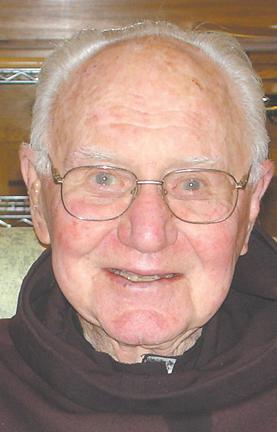

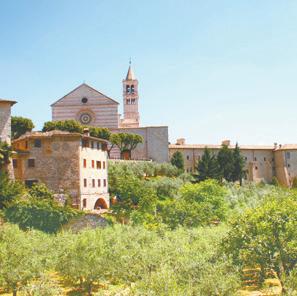








Fr Paul Smith OFM, Provincial Minister, presided at the funeral Mass and burial service at St Paschal’s College, Box Hill, Melbourne.
He was joined by 20 Franciscan Friars, other Religious and a large congregation of family, friends and Secular Franciscans.
“He had an incredible energy for promoting lay movements and worked in collaboration with the laity”.
As well as leading a renewal of the Secular Franciscan Order, Fr Joachim had a strong commitment to Marriage Encounter in its early years and to the Legion of Mary.
Vatican documents on lay ministry were his regular reading materials from which he drew inspiration.




“Not only did he read, quote and preach about these documents, he was instrumental in practical ways of promoting and supporting the vocation of the laity in today’s Church”.

For 48 years from 1962, Fr Joachim was a spiritual adviser to the Secular Franciscan Order, originally known as the Third Order of St Francis. He was a driving force in the renewal of the Order based on the revised Rule approved by Pope Paul VI in 1979. He wrote several instruction manuals and inspirational books about the life and ministry of the Order.
He continued his spiritual assistance to the Secular Franciscans until three months before he died.
Though very much a product of the pre-Vatican II era, Fr Joachim adapted
Fr Paul said: “The Franciscan Friars and hundreds of Secular Franciscans across Australia and New Zealand will remember Fr Joachim as a herald of the Gospel, a humble and true Franciscan, a loyal servant of the Church he loved and a thorough gentleman.”
- Information supplied by Franciscan Province
IN 2001, there were 5,001,624 Catholics in Australia (27 per cent of the Australian population) and 763,800 (15.3 per cent of the Catholic population) who regularly attend Church, according to the Australian Catholic Bishops Conference.
It is statistics like these and personal experiences of their own that have spurred some parishioners from All Saints Parish, Greenwood on to facilitate a group for nonpractising Catholics returning to the Church.
Fred Preshaw, Tony O’Dea, Patrick Horneman and Francis Barr spoke to The Record about their plans for welcoming such Catholics home.
Mr O’Dea admits returning to the Church was a struggle for him.
He believes his contribution to the group will be empathising with other non-practising Catholics and wishes such a support group had been there for him during his own journey.
He resumed going to Church after a diagnosis of prostrate cancer, now in its advanced stages.
When he was first diagnosed in 1999 with the illness, he continued to ignore his faith for two years.
“The biggest stumbling block was Reconciliation,” he said.
It was a burden he was to carry around for another year and a half.
Finally, he decided to approach a school friend who had become a priest.
Prior to the Confession, he was so nervous he took tablets to calm himself down, he revealed.
However, it seems the experience was worth the anxiety.
“Once I achieved reconciliation and could receive the sacraments, I never looked back,” Mr O’Dea told The Record
Mr Preshaw heard the idea for such a programme two years ago. He saw how it could benefit his own family.
“My wife and I have seven children. Only two of them go to Church,” he said.
Having family members who have drifted from the Church is not an uncommon occurrence.
The facilitators had their inaugural meeting on 2 March this year. Mr Horneman outlined what group members could expect to get out of their free six week support programme for a maximum of 20 people.
“By the end of the programme they will be reintroduced to the sacraments, given an overview of the Church since Vatican II, understand the key aspects of the Mass and have the opportunity to share their journey since leaving the Church.”
All facilitators were keen to emphasise that the programme would be non-judgemental.
Mr Barr acknowledged the pressures of modern life could be a contributor to people drifting from the Church. “This programme offers an easy opportunity to reconnect,” Mr Horneman added.
The programme will be run at the meeting room in All Saints Church every Monday from 7.309pm on a date yet to be decided.
Prior enrolment is not necessary and those interested are encouraged to just turn up.
The group will be advertised in the community papers, nearby schools and on a large banner outside the Greenwood parish.
For more information, contact Fred Preshaw on 9447 5433. Friends of participants are welcome.
THE Sisters of St Joseph of the Sacred Heart launched a new Web site March 11 revealing never before seen images of their foundress Blessed Mary MacKillop, readings of her final letters and virtual tours of her tomb and her last home, Alma Cottage in South Australia.
The interactive website, www.marymackillop.org.au, went online and was launched March at Mary MacKillop Heritage Centre in East Melbourne last week.
Josephite Sister Annette Arnold developed the site with Fraynework Multimedia, a Melbourne-based Australian company created under the auspices of the Sisters of Mercy named after Mother Ursula Frayne, who established their Order in Australia in 1846.
Fraynework also created One Body, One Spirit in Christ, the interactive catechetical DVD resource to be distributed throughout the English-speaking world by the International Committee on English in the Liturgy to help the faithful understand the newly translated Missal better.
Sr Annette said the new Blessed MacKillop

website “gives anyone interested in the story of Mary MacKillop an intimate and personal understanding of her life and the contributions she made to Australia”.
Director of Client Services of Fraynework Multimedia, Anne Walsh, said her team applied a range of modern technologies with visually rich graphic design to provide site visitors with an “engaging online journey” into
the life of the Blessed MacKillop, who is set to be canonized in Rome on 17 October by Pope Benedict XVI.
“The combination of captivating video, audio, art and historical imagery help bring the story of one of Australia’s great pioneering women to life in a compelling digital form,” Sister Anne said in a March 10 statement from Fraynework.





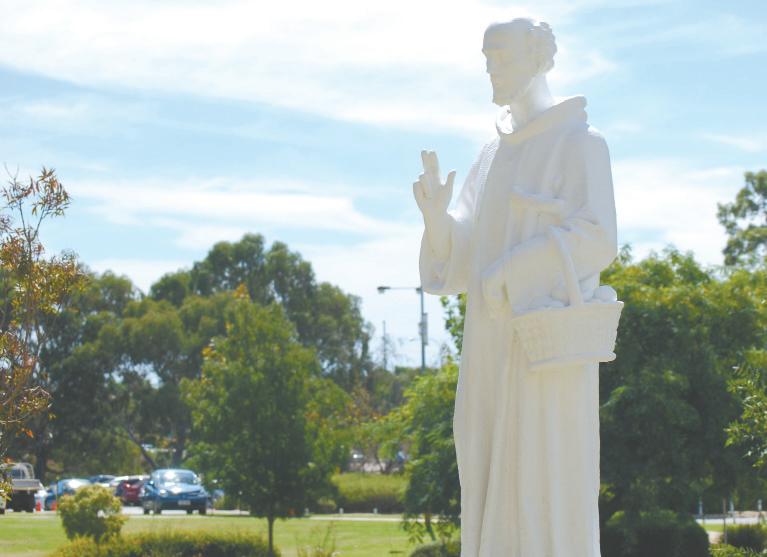

A STATUE of St John of God thought missing for the last 15 years has been returned to its rightful place on the grounds of St John of God Hospital Murdoch.
From 1934 until its closure in 1994, the statue stood in front of St John of God Hospital Rivervale.
When a passing Sister of St John of God noticed the statue of the patron saint on the Rivervale hospital site about to be demolished in 1994, she rang St John of God engineer Fred Foley.
“We rushed down there with a truck to find the statue still standing, with a bulldozer right there waiting. We used a crane to support the statue while we chiselled it away from its base,” Mr Foley said.
After years packed away in storage, the St John of God statue was refurbished and on his feast day on 8 March was unveiled as part of St John of God Day annual Mass and celebrations.
For St John of God acting director of mission Maureen Waddington, the statue has great symbolic value as it points to the ethos and charism of their founder and work.
“It’s a service ethos. We’d like people to say that we [at St John of
God] have come to serve and not to be served and to get a sense of Jesus’ healing mission. We are here to bring a reason for hope and a sense of dignity to all our patients and to each other.
“He [St John of God] was recognised as an important change agent in his community,” Mrs Waddington said of St John of God’s work in the early 16th century.
She added that St John of God started his health care work “as one man” in Granada in the south of Spain.
“He recognised some inequalities in his community and helped the marginalised off the streets and into the hospitals,” she said.
Mr Foley said that many people remember the statue of St John of God in Rivervale, prominently placed at the front of the property, where condominiums are now located.
“It’s like a long lost friend has come home,” he said.
He added that the statue is also a visual symbol of the spiritual heritage of St John of God Hospital Murdoch; although the hospital has only been in the community for 16 years, it stands on a continuum of St John of God health care that dates back to the 16th century.
Mr Foley stressed that St John of God Hospital “was not founded in a boardroom. It was founded by a desire to help those in the greatest need”.

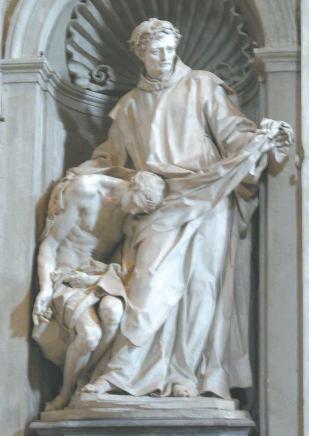
SAINT John of God was born in Monternor-o-novo, Portugal in 1495.
He worked as a shepherd in Spain up to his mid-20s and later served in the Spanish army against the French.
He later took part in another war defending Europe from Muslim invaders. After this, he wound up in Africa, nursing an exiled noble family. In his early 40s, while running a bookshop in Granada, he heard a sermon by travelling preacher St John of Avila on repentance, which changed his life. He was so overcome by the thought of his sins that the whole town thought the little bookseller had gone from simple eccentricity to madness.
After the sermon John rushed back to his shop, tore up any secular books he had, gave away all his religious books and all his money.
Clothes torn and weeping, he was the target of insults, jokes, and even stones and mud from the townspeople and their children.
He received the standard treatment for insanity at the time - daily whipping.
John of Avila came to visit him there and told him his penance had gone on long enough - 40 days, the same amount as the Lord’s suffering in the desert - and had John moved to a better part of the hospital. John of God could never see suffering without trying to do something about it (Catholic Online).
WESLEY
An annual exhibition by Western Australian Artists
Exhibition Times: Saturday 27th March to Monday
5th April, 2010. Open daily: 9am to 5pm
Easter Services:
Good Friday 10.00am, Easter Sunday 10.00am
Enquiries: Tel: 6103 4222 or Email: admin@ucic.org.au
Web: www.perthunitingchurch.org.au
Participating artists Karin Wallace, Tania Spencer, Peter Fitzsimmons, Hans Arkeveld, Vincent Elliott, Peter Kovacsy, Ron Nyisztor, Jane Martin, Sally Stewart, Wendy Lije, Connie Petrillo, Norma MacDonald, John Cullinane, Patrizia Tonello, Jennie Nayton
Cover image: Deposition (Station 13) by John Cullinane (2010)
AS part of St John of God Day celebrations, St John of God Hospital Murdoch announced the winner of its 2009 Caregiver of the Year Award, Emergency Department Patient Care Assistant Ricky Carpenter.
Ricky, a Leeming resident, was chosen from the 12 caregivers who had been recognised as Caregiver of the Month throughout 2009.
Ricky came to work for St John of God Hospital Murdoch when he and his family relocated to Perth after eight years working at Port Hedland Regional Hospital.
He brought with him great experience as a Patient Care Assistant, and commenced in the Emergency Department in January 2008.
Ricky’s wife Cynthia also works for St John of God Hospital Murdoch in the catering department.
The father of two was humble in accepting the accolade, and was genuinely surprised to be chosen as Caregiver of the Year.
“Listening to the stories of the others, I don’t think I deserve it. I just come into work and do my job,” said Ricky.
Ricky paid tribute to the winners of the Caregiver of the Month throughout the year and those who nominated them. The Caregiver of the Year award recognises and acknowledges excellent service and care provided by Murdoch caregivers, and is aligned to the hospital’s Mission and Values.
St John of God Hospital Murdoch Chief Executive Officer Peter Mott said recognising and
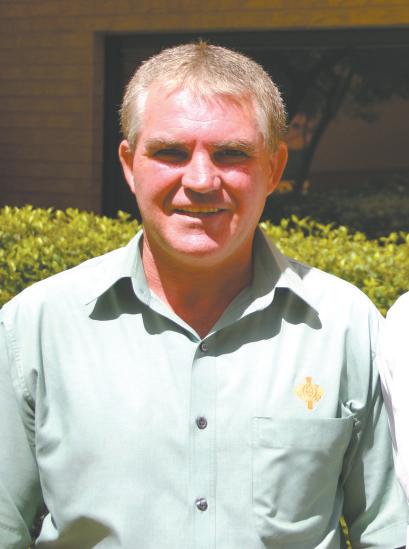
valuing the contribution of caregivers was an important part of the hospital’s culture and service ethos.
“Throughout the hospital, our caregivers are providing excellent care and service to our patients and their families, and our recognition programme is one way of recognising their contribution,” Mr Mott said.
“According to his colleagues and supervisor, Ricky is one of the best Patient Care Assistants they have worked with, and he is known as an extremely hard worker with a positive attitude.
“Ricky is truly committed to the Emergency Department and the services we provide, and we are fortunate to have him on our team. While only 12 people are formally recognised each year, so many more of our caregivers provide excellence in care and service, and we thank them all for their ongoing dedication.”
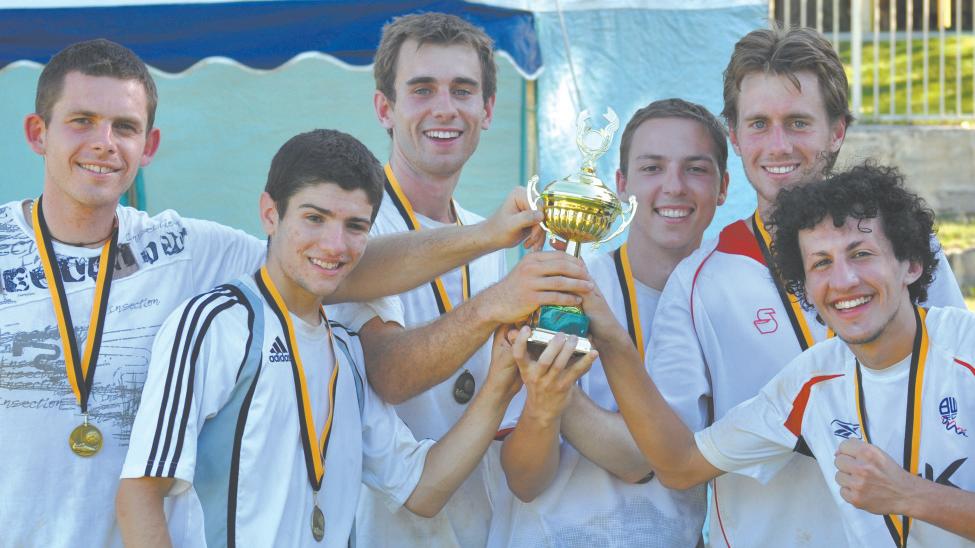
FIFTEEN teams contested Thornlie’s Sacred Heart parish’s third Inter-Parish Soccer Tournament on 1 March, minus its founder, Fr Pavol Herda.
Fr Herda was moved to Good Shepherd parish in Lockridge earlier this year, but the teams regardless braved 39C temperatures on the Monday of the Labour Day long weekend.
After being ordained to the priesthood on 6 June 2008, Fr Pavol started the soccer tournament upon arrival at Thornlie as a means of attracting and connecting with youth. The plan-
ning for this year’s tournament had already commenced when they learned that he was no longer going to be at Thornlie.
Invitations were sent to a number of parishes but those who accepted included Whitford, Bateman, the Burmese Catholic Community and Lockridge.
Lockridge earned a credible third place despite its first appearance at the tournament. Junior teams came from Whitford, Gosnells and Thornlie.
The Thornlie school oval had three matches playing simultaneously (two senior and one junior). A penalty shoot between Whitford 1 and Thornlie saw Whitford become the eventual winners of the Senior competition. The Junior winners were Diamond Backs of Thornlie in a back to back win.
Parish priest Mgr Tim Corcoran also braved the heat to give moral support.

ONE of the organisations answering the 2008 Senate Standing Committee’s recommendation to counter the inappropriate sexualisation of children has been the Catholic media company, Choicez Media.
Their latest DVD resource Beautiful, created for schools, parishes and groups that support women, is designed to provide an insight into the powerful media forces that are aggressively and often unconsciously shaping young women’s self-perception.
Choicez Managing Director, Jonathan Doyle, said that the three part DVD and accompanying support manual provides young women with strategies on how to deal with these forces and how to create changes, both in their own lives and in the wider culture.
Mr Doyle, who, along with his wife, Karen, established Choicez as a way to empower and equip young people with the skills and motivation to make positive and informed choices, has produced a number of high quality and acclaimed resources but is particularly excited about their latest product.
Speaking to The Record from his office in Canberra, Doyle said that since its release in February this year, over 180 schools from around Australia have ordered Beautiful and he expected that number to grow to about 500 by June.
The series combines the observations and ideas of high level academics and professionals with the experiences and reflections of young women to provide an awareness as well as an alternative to the negative influences that are subtly and deceptively wringing the innocence from today’s children.
The toxic messages being promoted by the popular media culture, according to Doyle, “are having profound effects on young women across a range of indicators from self-harm to eating disorders to early initiation of sexual activity” and he believes that Beautiful will be able to provide a counter-cultural alternative that will assist young people in understanding the deeper meaning of what it means to be a human person created in God’s image.
To view video extracts and interactive pages of the manual or to purchase the Beautiful resource, visit the Choicez website – www.choicez.com.au.
THE growing realisation of the harm being inflicted on young people by an increasingly sexualised culture has become the groundswell for what may be the next sexual revolution.
Studies and reports from the UK, US and Australia are consistently revealing the negative influences of a sex-driven media and the fight has begun to protect the youngest and most vulnerable members of society.
A report published by the UK’s Home Office last month confirmed the damage that is being caused by the escalating number of sexualised images and licentious media messages to which young people are being exposed.
The British government commissioned independent psychologist Dr Linda Papadopoulos to examine the effects of the increased sexualisation of society and to establish if there was a link to the growing violence against women.
The report, titled Sexualisation of Young People, defined sexualisation as “the imposition of adult sexuality on to children and young people before they are capable of dealing with it, mentally, emotionally or physically”.
Among Papadopoulos’ conclusions was the acknowledgement that not only had there been an unprecedented increase in the volume of sexual images in recent times, but that children were being portrayed with greater frequency in adult ways, while adult women were being infantilised. “This leads to a blurring of the lines between sexual maturity and immaturity,” she stated, “and effectively, legitimises the notion that children can be related to as sexual objects.”
The confusion that this creates in the minds of young women confirmed the findings of US psychologist, Mary Pipher, in her best-selling book Reviving Ophelia
Pipher believed that the toxic nature of the media culture was one of the major reasons that girls were, with tragic results, abandoning their true sense of self and adopting a dissociated identity that they believed would provide them with greater social acceptance.
It has led to an accelerated adolescence that encouraged girls to present and promote themselves in ways that are beyond their cognitive ability and sexual maturity.
It is a phenomenon that is being commercially reflected by the increasing number of children’s products that are being presented in a sexualised fashion such as dolls, clothes and toys.

The innocence of childhood is being eroded daily through the media and society itself and it appears, based on studies in the UK, US and Australia, that Western governments are waking up to it.
Papadopoulos is also concerned at the “pornification” of magazines, advertising and music videos that are being aimed at both male and female teenagers.
She says that these contain a predominant message for boys to be sexually dominant and to objectify the female body and for girls to measure their self-worth by how sexually desirable they can present themselves. “This sends out a powerful message to young people about what is of value and what they should focus on”.
Studies in Australia have similarly reflected the detrimental influences of a more sexually saturated culture. In 2006, Australia Institute, an influential Canberra based think tank, published two discussion papers on the sexualisation of children in the media.
The papers, Corporate paedophilia: sexualisation of children in the media and Letting children be children: stopping the sexualisation of children in Australia, triggered extensive debate and discussion across the country from academics to parents and in particular within the media.
In March 2008, the Senate referred the matter to the Standing Committee on Environment, Communication and the Arts to establish the gravity of the issue.
Their Report, tabled in June 2008, concluded that the “inappropriate sexualisation of children in Australia is of increasing concern” and a number of recommendations were made.
Most of these recommendations related to the Advertising Standards Board and classification issues; however, their 13th and final recommendation was of a more visionary nature: “The committee recom-
mends that state and territory governments, which have the responsibility for education, consider the introduction into all Australian schools of comprehensive sexual health and relationships education programmes which are inclusive of both young people and parents, adopting a consistent national approach to the question.”
FAMILY Voice Australia, a national ministry that seeks to uphold Christian values, has produced an open letter to Western Australian Premier Colin Barnett suggesting that two changes be made to the 2009 Child Exploitation Material and Classification Legislation Amendment Bill
The ministry is suggesting that the definition of “child” in the Bill be raised from 16 years of age to 18 and that the “literary” or “artistic” defence against child pornography offences be removed.
Those wishing to support the recommendations must send their response to Family Voice Australia by 31 March 2010.
To view or download the letter go to http://www.fava.org.au/content/fol-pdf-doc/584
KATOWICE, Poland (LifeSiteNews. com) - On 5 March the Katowice Appeal Court upheld the verdict of the Katowice District Court which ruled in September 2009 that the Polish Catholic newspaper Gosc Niedzielny (Sunday Visitor) and its editor in chief Fr Marek Gancarczyk were guilty of making offensive comments by saying abortion is the killing of an unborn child.
A further appeal is expected to go to Poland’s Supreme Court.
Fr Gancarczyk had appealed the earlier decision in the case brought against him by Alicja Tysiac, a woman who had previously won a “wrongful birth” suit against the Polish government at the European Court for Human Rights because she was refused an abortion.
Poland permits abortion only in cases of rape, serious handicap in the baby, or serious health risk to the mother.
Ms Tysiac, who has an eye condition,
had been denied an abortion because her doctors decided that the pregnancy would not seriously damage her health.
Following the European Court’s ruling, Fr Gancarczyk published an editorial condemning the court’s decision, saying, “In consequence, Ms Tysiac will receive 25,000 Euro damages, plus the costs of proceedings, for not being able to kill her child. In other words, we are living in a world where a mother is granted an award for the fact that she very much wanted to kill her child, but was forbidden to do so”.
The Katowice District Court ordered Fr Gancarczyk to pay US$11,000 and publish a court-dictated apology, which Fr Gancarczyk has refused to do.
Pointing out that the District Court judge said she deemed offensive Fr Gancarczyk’s statement that in seeking to get an abortion, the woman sought to ‘kill’ her child, the Appeal Court judge said in her decision that she believed the Catholic press should
refrain from using decisive and forceful language.
“Christianity is a religion of love and this is what the language used by Catholic press should be like,” the presiding judge stated.
An observer at the hearing told LifeSiteNews his opinion of proceedings: “The court was biased from the start. When the closing statements were heard in court, the judge could not sit still and listen to both sides, as is usually the case and a rule of good manners.
“The judge kept interrupting the speech of the defence, making faces and comments, indicating that the case was already lost for Gosc Niedzielny.”
Fr Jozef Kloch, spokesman for the Polish Bishops’ Conference, said that Christianity is a religion of love, which loves human beings from the first moments of life.
“It is also a religion which tells the truth, no matter how painful it is,” Fr Kloch added.
Continuing to sample Catholic press opinion from around the world, here is an editorial titled “A listening home” which appeared in the 17 February issue of The Catholic Messenger, newspaper of the Diocese of Davenport, Iowa and written by Frank Wessling.
This is also the time of year when many parishes make special efforts asking inactive Catholics to “come home.” Since there are millions of Americans who fit that category, perhaps a more sustained effort is needed - but one in which “home” clearly begins with listening.
The Church is what it is: a human thing with all of the stubborn mess that humans can make but also with all of the hope and goodness and more. Too many Catholics have been affected by the mess. They’re offended by mistakes, incompetence, arrogance, pettiness, the sin they’ve seen in the Church. They allow disillusionment to carry them away.
Too many have experienced nothing in the Church that feels like liberation. To the contrary, they project onto the discipline of the Church the frustrations that come from common limits and restrictions. Or they may prize the “seeker” name and avoid ties of Church membership.
Too many have looked for satisfaction from a bare minimum attachment. They may have done nothing more than show up at church for Mass most Sundays. If the music is mediocre, the ritual poorly carried out, the homily forgetful or irritating in some way, what is to keep such a person attached? For these reasons and more, and sometimes for no apparent reason, too many Catholics have not found spiritual food among us. We need to find out as much as we can about why this happens and the needs of those who walk away. We need to put aside notions we might have about the whys. We need to put aside our thoughts about some of the reasons, thoughts like those in the above paragraphs. We need to put our own agenda aside and begin by listening. We need to communicate our invitation in such a way that people hear our desire to listen without judgement. And listen. And listen. We should have our message ready when that time comes but it won’t come at all without a firm commitment to the listening. We can be attractive when following Jesus’ model of the meek and humble servant. Not so much, though, if we come across as the answer factory.
A number of readers requested the full text of the editorial excerpted on the ‘Seasons of Marriage’ from the 14 February issue of the Catholic Times, diocesan newspaper of Columbus, Ohio, and written by David Garick, editor. Here it is.
There’s a lot involved in building a marriage. Sometimes I am completely amazed that the institution works at all. After all, look at how we get into it. A young man and woman meet and a spark sets off this romantic explosion, creating an intoxicating atmosphere in which both of them lose most of their reasoning ability and connection to reality. Life begins and ends with each other. Your newly discovered mate can do no wrong. And when he or she does something wrong, it is quickly lost in the haze of newfound passion.
What do you do when the air clears and the reality of being a couple sets in? When we were newlyweds, my wife once asked me, “Can things really be this good?” I told her, “Of course they can. And they are just going to keep getting better and better.” Now there’s a tall order to fulfill. But I was young and optimistic. Thirty-three years later I’m still working on it.
What makes a marriage really good? I’m certainly no expert. I’ve screwed up many times over the years. But based on the notion that you learn much more from your mistakes than from your successes, I should, by now, have a wealth of knowledge. So, here are a few thoughts.
Flexibility is very important. Here, I’m talking about flexibility in the sense of bending over backward to accommodate each other. After all, this is the person you love. Besides, it is very hard to hit each other when you are both bent over backward. At our house, sometimes we have trouble getting things done because we are both trying to figure out what the other one wants.
Recognise that you are not going to change your partner’s basic traits. After all, that’s what attracted you in the first place. If you view your spouse as a rehab project, you will fail and have nothing but conflict. The amazing thing is that over the course of years when you have accepted your spouse for who they are, you find that they have morphed into the very traits you wanted them to adopt but could not force on them. My wife was always somewhat vexed by my nature of being very private, non-emotional and withdrawn into my personal shell. But she accepted it. Now I write about deep personal issues, feelings and spiritual matters and publish them in a newspaper. Go figure. Most important is faith. Christ taught us how we need to relate to each other. By worshipping together and taking in the lessons of holy Scripture and being in communion with Christ through regular reception of the Eucharist, a couple can also be in greater communion with each other. If Christ is at the centre of the family, it is very hard to get too far off course.
Marriage goes through many seasons. But just because the blooms of spring have faded is no reason to despair. God has provided other joys for each season of a relationship including the hectic summer pace of family and children, the colourful autumn of maturity and the comfort of bundling together in the serenity of life’s winter, secure in enduring love and companionship. It really does keep getting better.
that given the tone of the proceedings, an intrinsic link between the priesthood and what is often described to be the Western Christian concept of original sin is explicitly suspected. Given that this forms a chunk of the notable views presented by the speakers, notably Fr Laurent Touze, it does not do much justice to the Eastern Catholics on two counts.
In response to the two articles published in The Record of 10 March defending and justifying priestly celibacy, “Priestly celibacy: yes it is apostolic” and “No greater love: Rome conference speakers say celibacy mirrors Jesus’ love for all”, it is not my intention to enter into a polemical debate on the subject. However, I am concerned that such positions as those taken by your contributors give the impression that a non-celibate ie married priest is not what the Lord desires.
In 1969, three Anglican priests, of whom I am one, were joyfully received into the Catholic Church and ordained to the Catholic priesthood, with Papal Dispensation from the requirement of celibacy, all of us being married men with children. The Church accepted that we had received, and responded to, a genuine vocation to Christian ministry and that our marital status was no bar to ordination. Such has been the experience of many other married priests in Australia and overseas.
We were welcomed into the priesthood by our fellow clergy and, without exception, by the people whom we were called to serve. None of us was ever made to feel that our priesthood was in some way defective or displeasing to the Lord, from whom we had received our original calling. Our ready acceptance by the Church gives the lie to such a proposition.
Fr Geoff Beyer SwanbourneIrefer to the article “No greater love: Rome conference speakers say that celibacy mirrors Jesus’ love for all”. It would seem
Firstly, married priests were never an exception in the Eastern Catholic Churches. Secondly, the Western understanding of original sin does not apply to the Eastern Catholic Churches as the theological praxis in the Eastern Churches differs greatly from that of the Western Church. Here is what I suspect:
The Scriptures and Tradition of the Church teach us that the effect of original sin is death. However, some people tend to view Original Sin as a guilt passed on via the very act of sexual intercourse - even between spouses - and thus somewhat sinful and to be avoided. Hence, the movement in the West towards a celibate clergy historically had as much to do ensuring the ‘purity’ of the celebrant at the Liturgy as the commonly referenced prevention of property disputes raised by the progeny of the presbyterate.
Through this view then, the in persona christi view of the priest at Mass confuses the role of the priest as the president of the community (an essential part in Greek of the etymology of the term “presbyter” – how Eastern Catholics still primarily view the priest), with a somewhat magical ontological identification of the priest with our Lord offering Himself for the life of the world. This is clearly seen in the scholastic obsession that the recitation of the “Words of Institution” is the identifiable moment and necessary element to confect the transubstantiation of the bread and wine into the Body and Blood of Christ. This accounts for the absence of the Epiclesis in the Roman Canon.
On this count alone, Rome has had significant difficulties in recent years when accepting various ancient Churches of the East whose Liturgy never featured the Words of Institution at all into communion. Nevertheless, it has achieved communion with these Churches with great success.
The Eastern (notably Byzantine) Catholic tradition has always held the original position on both the Eucharist and the question of clerical celibacy. Regarding the Eucharist, it is the Epiklesis - the invocation of the Holy Spirit to
change the bread and wine into the Body and Blood of Christ - that effects the change in substance.
In this view, the priest or Bishop acts as president or overseer of the gathered Church with the spiritual authority and power to effectively call on the Holy Spirit for this change.
As the result of Original Sin is the corruption and death now rampant in Creation, the Sacraments of Holy Baptism and Chrismation make each Christian capable of achieving repentant growth in the Likeness of God. Additionally, ordination grants the permission for the cleric to lead the people in the Eucharistic celebration. That is the extent of the liturgia - the public work, the work of the people - in the participation of clergy and laity in the Divine Liturgy. It is the Holy Spirit who brings Christ to us through our thanksgiving and remembering of His Self-offering for us to His Father. Therefore, purity from sexual intercourse is not a necessity as has been impressed upon us through this conference.
It is true that married priests in the Eastern tradition are called to abstain from sexual relations on the eve of the weekly celebration of the Eucharistic Liturgy. However, this is part of the fasting and preparation for the reception of the supreme and highest Gift of God to humanity in the Body and Blood of Christ.
I have no intention of going against Church teaching, as the norm of married priests was always respected and held in high regard by Rome. In coming into communion with the Eastern Churches, the Roman Church was well aware of what it was doing, as it called for a high regard of the Eastern Catholic traditions. I suggest a deeper examination of Pope Leo XIII’s Orientalium Dignitas and Pope John Paul II’s Orientale Lumen to get a better picture.
Therefore, Fr Laurent Touze cannot suggest a celibate priesthood for all Catholics as that would be tantamount to instigating the Eastern Catholic Churches that an all-monastic episcopate be initiated in the Latin Rite. He too definitely cannot accuse the Holy See of trying to confuse the people of God by saying contradicting things on this issue. While the Church still hasn’t pronounced anything infallible concerning priestly celibacy, it certainly did not get itself confused and it certainly did not confuse the people.
Colin Michael Nunis MorleyContinued from Page 1 for Australians overseas - just as it ought to be.
“Australians who commit child sexual offences overseas will now be able to be punished even where foreign countries have deficient laws or are unwilling to prosecute.”
In 2007, the former coalition government introduced the Crimes Legislation Amendment (Child Sex Tourism and Related Measures) Bill, with nearly the same measures as those proposed in this Bill. The Coalition’s 2007 Bill lapsed with the proroguing of Parliament.
“Now, over two years later, we have the opportunity to put these measures in place,” Ms Moylan said. Commonwealth, State and Territory laws currently criminalise child abuse and distribution or possession of child pornography within Australia.
In 2005, the former Coalition government responded to increased use of the Internet by purveyors of child pornography
and perpetrators, strengthening the provisions of the Commonwealth Crimes Act and targeting the use of carriage services such as mobile phones.
The current Federal Bill builds on those reforms to ensure that the laws continue to remain effective and meet the needs of law enforcement agencies, combatting contemporary offending, Ms Moylan said.
The matter of the abducted children was first brought to public attention when Archbishop Barry Hickey, vice president of the Australian Catholic Bishops Conference, appealed in writing to Foreign Affairs Minister Stephen Smith on 18 February.
“I respectfully ask you to take whatever steps you can to discover the fate of these children and the people responsible for their disappearances. The matter is urgent,” he said in the letter.
Mr Smith responded by ordering Australian Embassy officials
in Bangkok to liaise with the Thai Ministry of Foreign Affairs.
Archbishop Hickey also wrote to Madam Navanethem Pillay, the UN’s High Commissioner for Human Rights based in Geneva, urging her to intervene in the matter with a view to finding the perpetrators and rescuing the children.
“I cannot express how distressing and shocking this incident has been for the Orphanage staff and the other children. It is shared by great numbers of people here in Western Australia, where it has had some publicity,” Archbishop Hickey said in the letter to Madam Pillay.
Adelia and Norman Bernard of Midland, who brought the issue to Archbishop Hickey’s attention, set up the One Heart Association to fund the Sang Khan Buri orphanage to the tune of $700 a month for the care of over 90 children in the orphanage for the past six years.
Is the diaconate merely a roadblock to women’s ordination?
The geographical spread of deacons in the universal Church, presented in earlier articles, seems to suggest that there are varying degrees of acceptance within dioceses of the importance and role of deacons in the life of the Church.
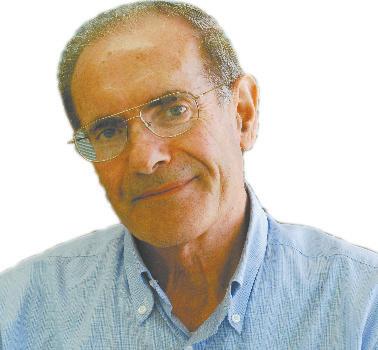
The permanent diaconate: Its genesis, growth, issues.
By Anthony Paganoni CSOverall, it would appear that convinced advocates for the diaconate are still a small minority, actually less than those who have decided, for their own reasons, not to have a bar of it. It is clear that not every theologian sees the restoration of the permanent diaconate as a boon to the Church or approves the way it has been functioning. Several theologians come to mind: George Tavard, Basil Hume and John N Collins. Their reasons vary, but two arguments seem to be uppermost: the permanent diaconate represents a roadblock on the highway towards the ordination of women to the priesthood and also impedes a greater involvement of the laity in the Church.
Not an insignificant number of priests and Religious believe that, in order to allow women to build up the Church as priests or the laity to vigorously pursue their baptismal calling in an unshackled manner, it is crucial to deprive a particular category of men from offering themselves as ministers to build up the Church as deacons. On many occasions I have heard priests and Religious say that the diaconate was a lesser priority than the ordination of women or a heightened level of service of the laity. Yet, I have never heard them support the abandonment of priesthood to further the same cause. Such stark alternatives are seldom fruitful. A Canadian liturgist, Sherri L Vallee, is particularly emphatic. Writing in the journal Worship in 2003, she states: “The (Vatican) Congregation for Catholic Education and the Congregation for Clergy appear to have decided on a view of permanent diaconate that blurs the distinction between diaconate and presbyterate, that requires a very well-formed diaconate and that gives deacons many liturgical responsibilities that they did not have in the past.
“This decision represents a loss to the Church, because deacons in such functions cannot symbolise Christ as the humble servant in our midst. Moreover, when deacons baptise regularly, the connection between Baptism and the Eucharist is obscured. When deacons preach at Mass, the connection between the Liturgy of the Word and the Liturgy of the Eucharist is less clear. Accentuation of a deacon’s liturgical and sacramental responsibilities will undoubtedly lead to a further diminution of the Church’s attention to the social welfare needs of our communities.”
The Australian Scripture scholar, John N Collins, cautions against going back to the uncritical acceptance of diakonia, as reportedly practised by the early Church, for proffering a doctrinal and pastoral basis for the diaconate in the modern world.
This is an emphasis that still remains dominant, though in recent years, increasingly called into question as the overriding factor in discussing the issue of identity and usefulness of permanent deacons.
Does Richard Dawkins’ aggressive faith in the non-existence of God represent an embarrassing gap in his knowledge of history, cultures and religions?


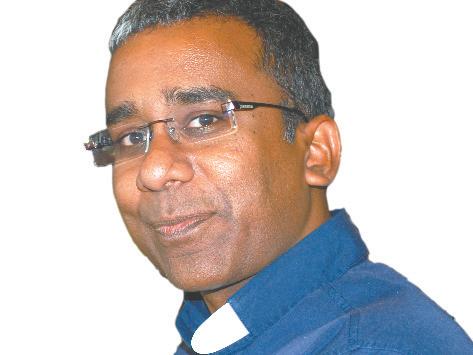 By Fr Sean Fernandez
By Fr Sean Fernandez
Ihave been diverted from the article I was going to write by the visit to Australia of the congenitally arrogant Richard Dawkins. He is a darling of the media, of course. We do like to hear our bigoted ideas dressed up as science; it is so reassuring. Richard Dawkins’s utterances rely on the ignorant prejudice of his hearers.
This is all very ad hominem, but Dawkins made some egregious remark about ‘Pope Nazi’ when he was speaking at the Church of atheism of which he is high priest.
This is a cheap slander as it is well known that the Ratzinger family was strongly opposed to National Socialism.
Having got that off my chest, let me turn briefly to his latest contribution to the ‘religion debate’. He demonstrates that Noah’s Ark could not have existed. OMG! My goodness! My faith is shattered!
This is Dawkins at his intellectual best –he sets up straw men to knock down.
But if one were to scan his pronouncements on religion one would find that his bête noire is a fundamentalist brand of faith.
There are libraries full of books exploring biblical archaeology, history, interpretation and the religious myths of the peoples of the Ancient Near East.
Mr Dawkins appears to be in blissful ignorance of the existence of these.
He has posited that sophistication with regard to biblical interpretation is a new phenomenon. If he had bothered to pick up an undergraduate text on the study of the Fathers of the Church he would know how nonsensical that is.
In the fourth century, one can quote Victorinus of Poetovio who wrote that it was more important to understand the order of logic of words rather than the strict ordering on the page. And earlier the great Origen (185-254) wrote of the priority of the spiritual sense (Handbook of Patristic Exegesis, Kannengiesser, ed.167).
Writing on St Augustine, Kenneth Hagan says that he had a “complicated ... and multinuanced view of Scripture” (Bible in the Churches: How Various Christians Interpret the Scriptures, 5). This approach to Scripture continued into the Mediaveal period.
Early and mediaeval Christians were very sophisticated in their use of Scripture. It is a pity that Mr Dawkins is unable to show such sophistication.
As I said, Dawkins’ quarrel is with a certain fundamentalist Christianity. This fundamentalism is a new phenomenon and has its roots in the 19th and 20th centuries.
In the early 20th century a series of volumes entitled The Fundamentals were published upholding what the authors considered ‘traditional views’ of the Bible; these volumes and the movement behind them were the midwives of fundamentalism in Biblical interpretation.
Let me turn briefly to the account of the flood. The Bible is not the only text which speaks of a flood; other texts from the Ancient Near East speak of such an event.
There does appear to be some archaeological evidence of a flood which may have had a dramatic impact on the region and so on peoples’ collective memories.
This is not to argue for the existence of an ark. The interesting aspect of the Biblical narrative is the manner in which the story is given its particular shape by the people’s faith in Yahweh.
But one cannot expect Dawkins to notice such nuance. Please note that I write as a theologian and not as a Scripture scholar and am open to discussion with my colleagues.
Dawkins is a biologist whose contribution to thought, according to all accounts, is the theory of memes – ‘a cultural replicator’.
But as Professor Alister McGrath (the eminent molecular biophysicist and theologian) points out, there is no “direct evidence for the existence of memes” and the argument for the existence of memes is based on questionable assumptions.
Is there even a need for memes as explanatory function? Nous n’avons pas besoin de cette hypothèse - we have no need for that hypothesis (with apologies to Laplace). McGrath quotes the palaeontologist, Simon Conway Morris, who wrote of Dawkins’ pet theorem – “Memes are trivial, to be banished by simple mental exercises. In any wider context, they are hopelessly, if not hilariously, simplistic.
To conjure up memes not only reveals a strange imprecision of thought but, as Anthony O’Hear has remarked, if memes really existed they would ultimately deny the reality of reflective thought.” (Alister McGrath, Dawkins’ God: Genes, Memes and the Meaning of Life)
Perhaps Richard Dawkins should devote his energy to salvaging his own pet hypothesis instead of commenting on topics about which he is embarrassingly ignorant.
This poem concerns the soul finally at peace after death, something to look forward to in the hardest trials of life.
Never more to weep or cry
To pause for strength, in grief to sigh
Forever gone the burden strong
The weary nights in which we long
For peace and joy and waters still
Our thirst to quench, our hunger fill.
There upon the mountain high
Beneath the blue and glorious sky
The journey past we’ll look upon
As lessons learnt in right and wrong
In rest the heart will find its peace
Forever more to know increase.
Music there shall fill the air
The sight of Him will be our fare
Wine divine shall flow in streams
Where all we see is as it seems
In joy forever to adore
The Fount upon the endless shore.
- Fr Sharbel M Hayward FIA poem about conversionand the temptation to despair.
In the hour of my need
The voice was found to pray
When all would bid me flee from you
Your love bid me to stay.
From the hidden darkened depths
Where memories fade to naught
When falling seemed forever more
My wounded heart was caught.
Basking in Thy light divine
And nourished by your grace
No longer would I hide my gaze
From your resplendent face.
At peace within at peace with you
Subdued the frantic race
Nearer now each day each hour
To You in Your embrace.
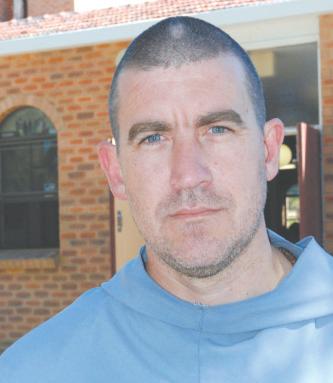 - Fr Sharbel M Hayward FI psharbel@gmail.com
- Fr Sharbel M Hayward FI psharbel@gmail.com

Patrick Fagan - whose Mapping America project has provided volumes of data on the connections between religious faith, intact families and healthy citizenship - argues that most social scientists are uncomfortable with discussion of certain topics - mostly those which prove that the Catholic Church is spot on when it comes to traditional moral law for the betterment of mankind.
“Most of the untouchables are in the realm of the sexual, the battleground of the clash of civilisations,” he says. Those who oppose the Church do not use the social sciences to disprove the Church’s positions, but instead discourage investigation of the data ... because, he suspects, THE DATA MAY ACTUALLY BOLSTER
Recently, I received an email about my findings about social trends in America from an eminent social scientist at an Ivy League university: “Dear
Pat: Showing these bi-variate comparisons as you do is both misleading and amounts to nothing more than propaganda for your point of view. You should and, I think do, know better! Please unsubscribe.”
A word of explanation: “bivariate analysis” – my alleged crime – is the use of simple correlations.
Now every undergraduate knows, and prattles on about all too often, that “correlation is not causation”.
And very good it is that they know this is the case.
But too many people blithely dismiss correlations, especially when they seem to point in uncomfortable directions, such as the correlation between the number of sexual partners before marriage and the rate of the breakdown of marriage later on.
Young people and many of their social science professors prefer to avoid such data.
My offending numbers can be found at Mapping America, where various issues are illustrated from federal government surveys that permit a look at the US population through the lens of marriage and religious worship.
On issue after issue, we find that the pattern is very robust. Take a fairly uncontroversial yardstick such as grade-point-average: highschool-age children from alwaysintact married families score highest; those who worship weekly also score high; and those from intact families that worship weekly score highest of all.
On negative issues, such as drug use, the reverse is the case: those from married families who worship weekly have the lowest rates of negative behaviours.
We have been compiling these figures to bring a simple truth to public attention and to the academic debate: that marriage and religious worship are fundamental to individual well-being and to the normal functioning of society.
The good professor was irritated, I suspect, because the pattern is becoming so glaringly repetitive that the question must arise about what is powerful enough to cause these differences.
I think it is “love”; to be precise, the two great loves: love of God, with worship as a social science proxy measure; and love of neighbour, with marriage as a social science proxy measure.
But being on the “other side” on many of the social issues in debate today, my academic critic is more likely discomforted than intrigued by the charts, because a lot is at stake.
He has not yet steeled himself to grapple with something I stumbled on as a Catholic undergraduate in
“Cumulative Number of Women’s Lifetime Sexual Partners” by Religious Attendance and Present Family StructurePATRICK F FAGAN, PH.D. AND D PAUL SULLINS, PH.D.
WOMEN in always-intact marriages who worship at least weekly are more likely to have had fewer lifetime sexual partners than those in other family structures who never worship.
According to the National Survey of Family Growth (NSFG), women in always-intact marriages who attend religious services at least weekly have had, on average, 2.42 lifetime sexual partners, followed by women in always-intact marriages who never worship (4.71), those in other family structures who worship at least weekly (5.51), and those in other family structures who never worship (9.07).
Examining present family structure only, women in intact cohabiting relationships have had, on average, 2.33 lifetime sexual partners, followed by women in always-intact marriages (3.23), those in cohabiting stepfamilies (6.34), those in married stepfamilies (6.98), those who have always been single (7.44), and those who are divorced (8.18).
Examining religious attendance only, people who worship at least weekly have had, on average, 4.33 lifetime sexual partners, followed by those who worship between one and three times a month (6.25), those who attend religious services less than once a month (7.56), and those who never attend religious services (8.84). These charts draw on data collected by the National Survey of Family Growth, Cycle 6 (2002). The sample consists of women between the ages of 35 and 44 and numbers 2,479.
the social sciences. In my junior and senior years, I learned a profound lesson: Well done, the social sciences cannot but illustrate the way God made man.
At that stage in life, I was a little weak in trusting God and was afraid that positions like those in Humanae Vitae which had just been promulgated, might confront me with good social science on one side and the Church’s teaching on the other.
The first time I came across the potential conflict, I was reading a research article by a well known social scientist. I dug into the data, anxious that I might have to choose between the Church and science.
But the more I looked, the more I found that it was his deductions from the data – his take on reality – that were at odds with Church teaching, not the actual data themselves.
This experience repeated itself for me a number of times, until I
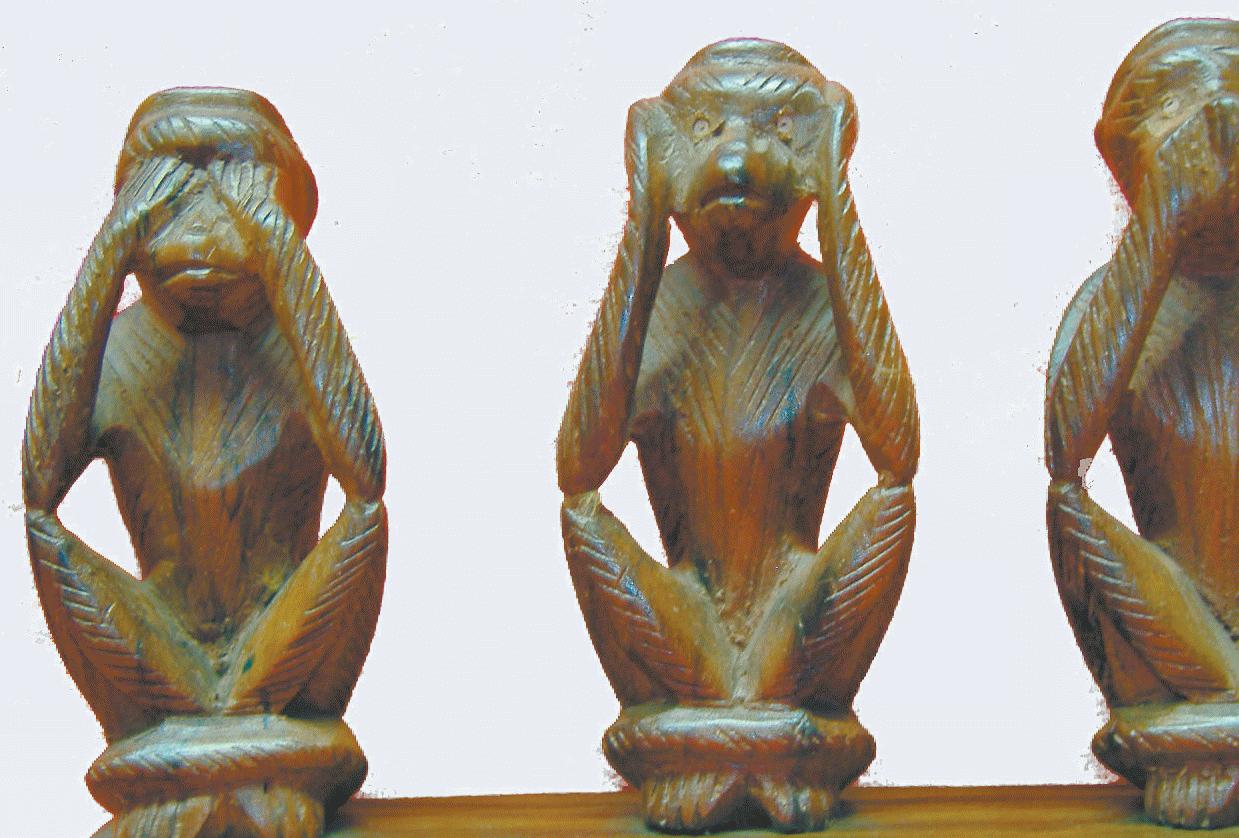

Several other studies corroborate the direction of these findings. Jay Teachman of Western Washington University reported that women who engaged in multiple premarital intimate relationships increased their risk of divorce (Jay Teachman, “Premarital Sex, Premarital Cohabitation, and the Risk of Subsequent Marital Dissolution among Women,” Journal of Marriage and Family 65, 2003: 444-55).
saw the pattern that is now familiar: the social sciences illustrate the way God made man. Social scientists often disagree with the Church but their data do not.
Increasingly, the Church stands before the world as the only great institution courageous in both truth-seeking and truth-telling.
As all well formed Catholics know, the Church has nothing to fear from truths about Creation.
The only thing the Church fears is sin and its fruits. God and His Creation are to be embraced, accurately known, and loved.
The academy ought to be an institution dedicated to the search for truth. In the physical sciences that happens, by and large.
Though scandals sometimes occur in the physical sciences, the way they are handled (for the most part severely) testifies to that dedication.
In the social sciences, the abuse lies not in directly falsifying data (where the punishment is also
Jason Weeden of Arizona State University and colleagues also found that religious attendance correlates to a marriagecentered sexual and reproductive strategy (Jason Weeden, Adam B Cohen, and Douglas T Kenrick, “Religious Attendance as Reproductive Support,” Evolution and Human Behaviour 29, 2008: 327-34).
Wade C Rowatt of Baylor University and David P Schmitt of Bradley University reported that those who view religion as an end, rather than as a means to another personal or social end, show less interest in hav-
severe), but in deliberate avoidance or blocking of investigation of a host of “politically incorrect” topics such as the effects of abortion, the psychogenesis of homosexuality, or the consequences of contraception.
Most of the untouchables are in the realm of the sexual, the battle ground of the clash of civilisations.
In this clash, those who oppose the Church do not use the social sciences to disprove the Church’s positions, but instead discourage investigation of the data because, I suspect, the data may actually bolster traditional natural law.
John Boyd, military strategist, engineer, fighter aircraft designer and Top Gun of all Top Guns, has a great saying: “The data that do not fit are the most important data of all.” It leads us to new discoveries, to upending our own pet views of the world, or our academic theories when they don’t square with reality.
Today, many social scientists flee
ing multiple sex partners (Wade C Rowatt and David P Schmitt, “Associations between Religious Orientation and Varieties of Sexual Experience,” Journal for the Scientific Study of Religion 42 (2003): 455-65).
As the evidence indicates, women in always-intact marriages who worship at least weekly have fewer sexual partners than those in most other family structures who worship less frequently.
By Dr Fagan is senior fellow and director of the Marriage and Religion Research Institute (MARRI) at Family Research Council. Dr Sullins is an associate professor of sociology at The Catholic University of America.
from uncomfortable data and in this flight are being untrue to their vocations.
They are also slowing down the real progress that the social sciences might offer us. My eminent sociologist is an unfortunate example of a large cohort who see mere candid descriptions of reality as religious propaganda.
But this obvious averting of the gaze witnesses to the potential power of the social sciences to confirm natural law and help the Church help man be true to himself. To work as a truth teller in this field is a great vocation for bright young people.
The good news is that some of our best and brightest are now ploughing there. Despite attempts to suppress their voices, you’ll soon be hearing more from them.
Patrick F Fagan, Ph.D. is the author of The Effects of Pornography on Individuals, Marriage, Family and Community an extensive review of the social science literature on the effects of pornography.
Column courtesy of insidecatholic.com
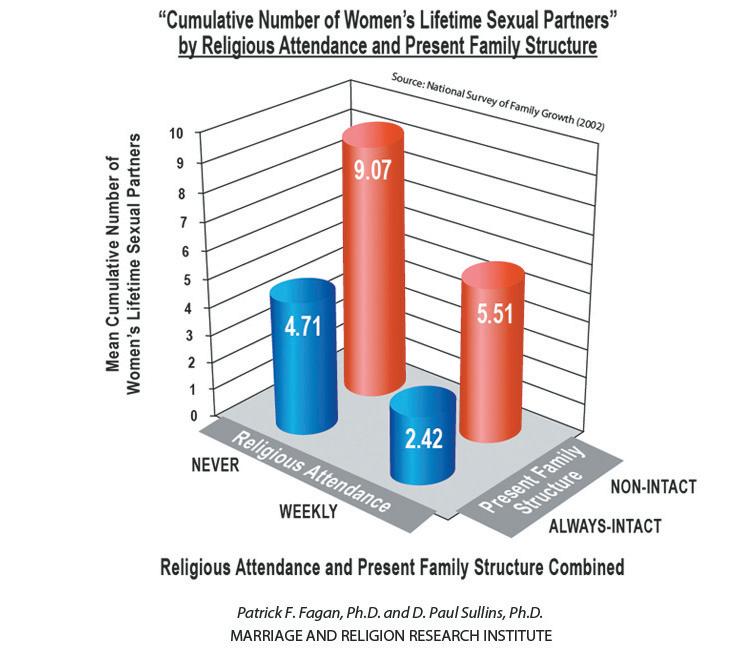

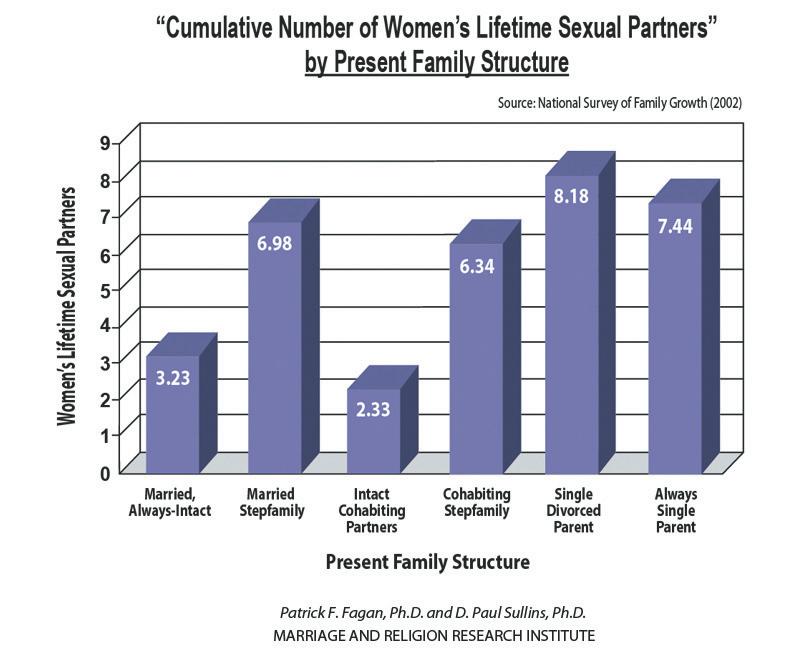

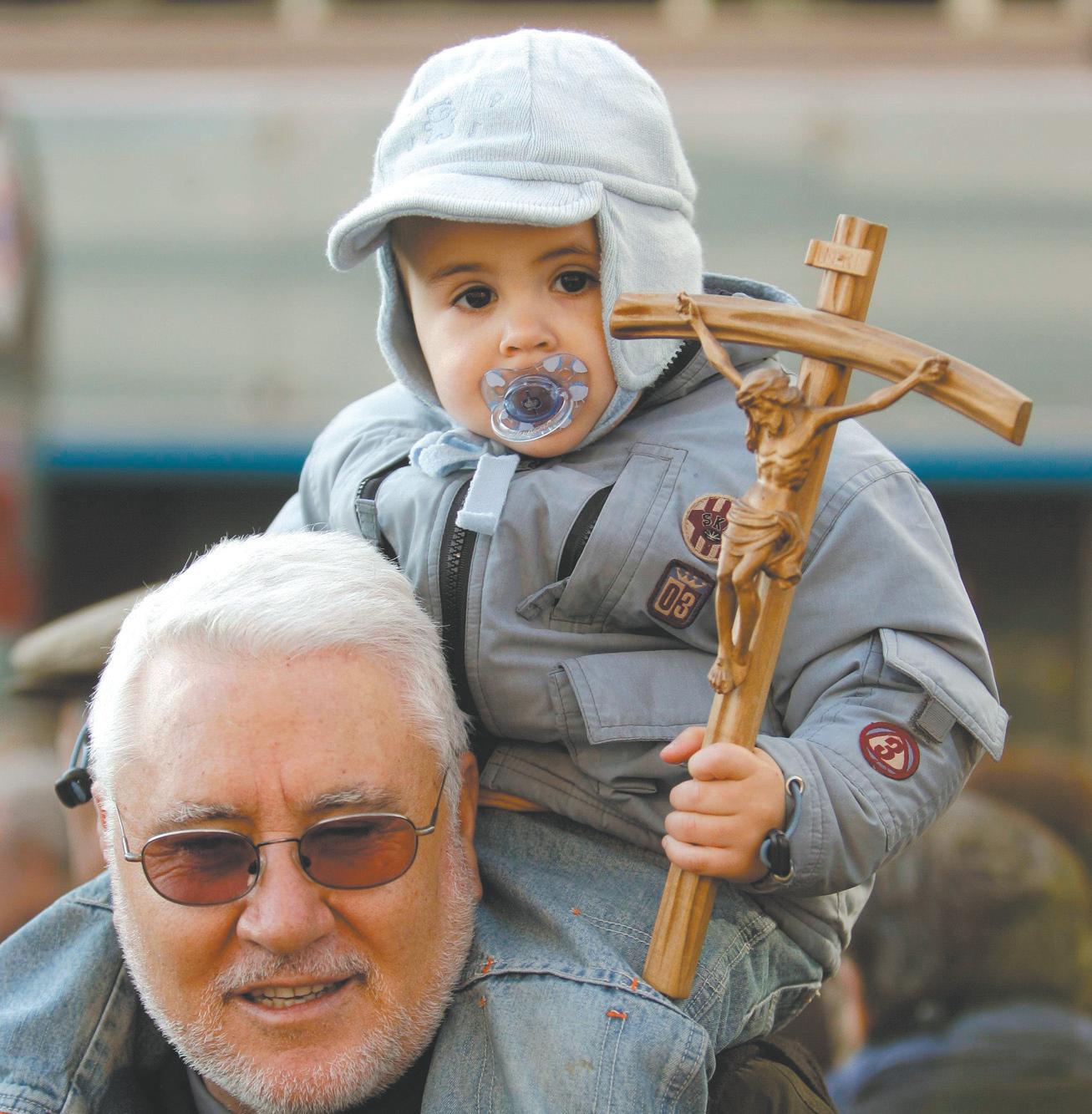
ROME - Love, honesty and devotion to Christ are essential for facing the crisis in the Church and in the priesthood caused by cases of clerical sexual abuse, an Australian Archbishop said.
Since the 1990s, when the scandal first broke, “everyone has learned that several points are crucial: care for the victims, following the law, dealing effectively and decisively with perpetrators, making sure we have proper procedures in place to safeguard children and backing up what we believe with our actions,” said Archbishop Philip Wilson of Adelaide.
The Archbishop is a longtime participant in what is known as the Anglophone Conference, an international group of Bishops and Church child protection officers who have met annually for almost 20 years to identify effective strategies for combatting and responding to clerical sexual abuse.
“We must be humble and accept the pain of the present moment as the horrible realities are revealed,” he said on 11 March during a break in a theological conference on the priesthood.
More than 500 Cardinals, Bishops and priests gathered at Rome’s Pontifical Lateran University for the opening session of the conference sponsored by the Congregation for Clergy to mark the Year for Priests.
The clerical sex abuse scandal was mentioned only in passing the first morning of the conference when an Italian sociologist said the scandal in the United States has not appeared to have a negative impact on vocations.
Bishop Gerhard Muller of Regensburg, Germany, where the latest scandal has involved the diocesan Cathedral’s famous boys’ choir and school, was one of the main speakers on the opening day of the conference.
He did not mention the scandal in his talk on the role priests play in shaping culture and their obligation to promote a culture of life.
During a break in the conference, he told reporters it was “stupidity” to believe that celibacy
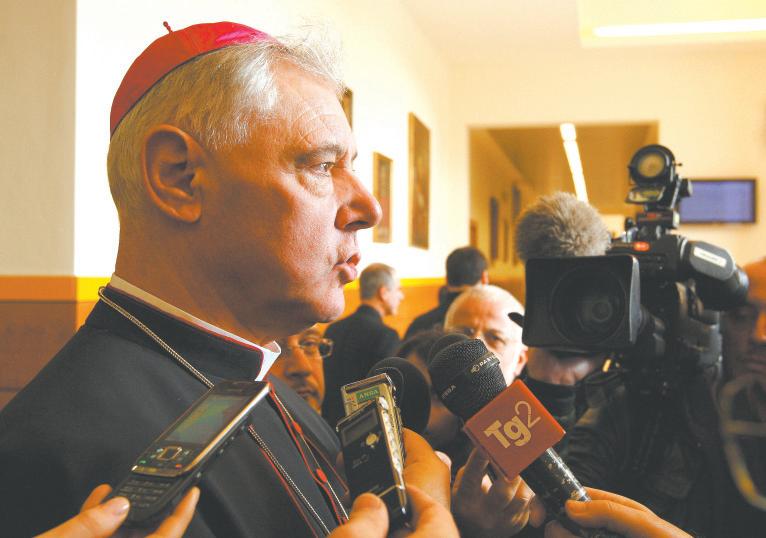
caused clerical sexual abuse and he said that any priest who sexually abuses a child has placed himself outside of the priesthood, even before the Church acts to formally dismiss him.
The connection between celibacy and sex abuse was raised in media reports on 10-11 March about a message written by Austrian Cardinal Christoph Schonborn of Vienna to pastoral workers in his Archdiocese.
The Cardinal wrote that to prevent future cases, the Church needs to examine “the question of the formation of priests” and the impact of the sexual revolution of the 1960s on priests.
“The theme of celibacy as well as the theme of the development of personality” should also be studied, he wrote.
The Cardinal’s secretary told CNS that journalists had misunderstood his remarks; the Cardinal, he said, was not questioning the Church’s discipline of celibacy for priests nor implying there was a connection between celibacy and sexual abuse.
Honduran Cardinal Oscar Rodriguez Maradiaga of Tegucigalpa told reporters at the Rome conference: “There is no relationship between celibacy and paedophilia. I do not see how there can be a connection between celibacy and abuse because there are also abusers found among those who are not celibate. It’s just that people don’t hear about it.”
The Cardinal, who holds degrees in clinical psychology and psychotherapy, said the Catholic Church “must compensate victims,
not just with money, but with real assistance.”
Meanwhile, the Vatican’s representative to UN and other international agencies based in Geneva spoke of Pope Benedict XVI’s “unambiguous condemnation of sexual violence against children and young people.”
Archbishop Silvano M Tomasi said that in cases of sexual abuse of children, the victim’s “physical and psychological integrity is violated with destructive consequences,” including increased probability of teenage pregnancy, homelessness, drug and alcohol dependence.
He acknowledged the involvement of Catholic clergy and lay people in such crimes and said “protection from sexual aggression remains high on the agenda of all Church institutions as they struggle to come to terms with this serious problem.”
The Church is committed, he said, to ensuring transparency in the process and offering help to victims and their families “to alleviate the pain, grief and bewilderment caused by the abuse that has occurred.”
Archbishop Tomasi said that anyone found guilty of sexual abuse is suspended immediately from their ecclesial office and are dealt with according to the norms of civil and canon laws.
The most important thing is prevention which, he said, “begins with education and promoting a culture of respect of the human rights and human dignity of every child,” and especially by improving methods of choosing school personnel.
Government ‘not using abuse to undermine or eliminate the Church’ Report expected in April on investigation into abuse by Dutch clergyBY JONATHAN LUXMOORE Catholic News Service
WARSAW, Poland - An independent Church inquiry into alleged sexual abuse by Catholic clergy in the Netherlands will submit its report by late April, according to a spokesman for the Dutch Bishops.
“Although we don’t yet know how the investigations will be carried out, and which organisations will be asked to help, we know the inquiry will be independent and vigorous,” said Bert Elbertse, communications director for the Dutch Bishops’ Conference.
“Although initial reactions to these accusations were very negative, of course, current newspaper coverage and public comments suggest people are waiting sympathetically to see what comes of the investigation,” he said.
Elbertse’s comments came after the investigation into alleged abuse by priests at Dutch Church schools was announced in a 9 March statement by the Bishops after their plenary meeting in Zeist.
In an 11 March interview with CNS, Elbertse said individual criminal cases would take longer to investigate and follow up.
Wim Deetman, a State Council member and former education minister tasked with heading the inquiry, planned to outline his plans for the investigation on 12 March.
“As a Protestant, he’s well known in Church organisations, and can easily find the right people and means to help him,” Elbertse said.
About 350 people have registered abuse claims since late February with the Church’s Help and Law organisation, set up in 1995 by the Dutch Bishops to help alleged victims.
Jan Waaijer, the organisation’s spokesman, said on 9 March he was shocked by the “flood of claims”.
In their 9 March statement, the Bishops said they were “deeply affected” by the “moving stories of sexual abuse,” which violated human dignity and Gospel values and deserved

“powerful condemnation.” The Bishops also said that a “broad, external and independent investigation” by Deetman was a priority.
They named Bishop Gerard de Korte of Groningen and Leeuwarden as “referee and spokesman” for the Bishops’ Conference on the issue.
Elbertse told CNS that Bishop de Korte could be expected to play a role similar to Bishop Stephan Ackermann of Trier, recently named to oversee abuse claims for the Church in neighbouring Germany.
He added that the Help and Law organisation had already given the Church experience in handling accusations, and said he was not aware of any cases of attempted blackmail against Dutch clergy.
“Most complaints seem to relate to events many years ago,” Elbertse said.
“Although Dutch politicians and parties have reacted in various ways to our handling of this controversy, I haven’t seen any signs so far that anyone is using it to undermine and eliminate the Church,” he added.
Speaking on 9 March, Bishop de Korte said the Bishops’ conference had entrusted the investigation to “somebody from outside the Roman Catholic circle,” to show “we are striving for as open an investigation as possible and that we, as the Catholic Church, do not want to hide anything”.
● Catholic Church officials in Switzerland have revealed that they are looking into about 60 reports of sexual abuse by priests.
They said that they will recommend that victims bring their complaints to public prosecutors.
The Church in Switzerland thus joined the German and Austrian Catholic communities, which have been battered in recent days by reports about abuse.
DUBLIN, Ireland - Cardinal Sean Brady of Armagh, Northern Ireland, chairman of the Irish Bishops’ Conference, insisted he will not resign after it was revealed that he failed to report allegations of child abuse by a priest to the police in 1975.
Speaking with reporters on 14 March, Cardinal Brady said it was not his responsibility at the time to report the allegations involving Norbertine Fr Brendan Smyth to the police. “Even today the appropriate person to do that is the designated person (within his Order). I was not that person,” he said. “But I insist again I did act, and
act effectively, in that inquiry to produce the grounds for removing Fr Smyth from ministry and, specifically, it was underlined that he was not to hear confessions and that was very important. The responsibility for his behaviour as a priest rested with his Religious superior,” he added.
The allegations surrounding Fr Smyth involved a group of teenagers who told then-Fr Brady that the priest had abused them. At the time, Cardinal Brady insisted that the complainants swear an oath of secrecy and not discuss what happened with anybody other than an approved priest.
After a Church inquiry, Fr Smyth was removed from active ministry. However, civil authorities were not informed of the
allegations and Fr Smyth continued to abuse children until his eventual arrest and conviction in 1994. Details about the meetings between Cardinal Brady and the teenagers were revealed by an attorney representing a woman in a lawsuit who claimed that Father Smyth abused her.
The lawsuit in the Irish High Court said Fr Smyth assaulted and beat the woman. The suit named Cardinal Brady as one of three defendants. The others are Fr Gerard Cusack, head of the Norbertine Order, and Bishop Philip O’Reilly of Kilmore, Ireland, where Fr Smyth was assigned. Cardinal Brady told reporters he had been following his Bishop’s orders and there were no guidelines for dealing with abuse
investigations in 1975. He insisted that “this is not a resigning matter.”
In December, following an independent report that faulted the Church for its handling of 325 sex abuse claims in the Archdiocese of Dublin in the years 19752004, Cardinal Brady said he would resign if he was found to have acted improperly.
The Norbertine Order admitted that it was aware of the allegations against Fr Smyth as early as the late 1940s. He was moved from parish to parish and between dioceses whenever allegations were made against him. In some cases, the Order did not inform the diocesan Bishop that Fr Smyth had a history of sexual abuse and should be kept away from children.
VATICAN CITY - Pope Benedict XVI encouraged German Bishops to continue with their efforts to aggressively confront and seek solutions to the widening scandal of sexual abuse of minors in Catholic schools, the head of the German Bishops’ Conference said.
Archbishop Robert Zollitsch of Freiburg told reporters that in a 45 minute private meeting on 12 March, the Pope encouraged him to move ahead “with decision and courage” in investigating old cases and preventing new ones.
At a news conference held at the Teutonic College inside the Vatican, Archbishop Zollitsch said the Pope was “deeply moved” and listened to the facts surrounding the many claims of abuse of minors in his native Germany “with great interest and great dismay.”
Later, on 12 March, the Vatican responded to a German report about a priest accused of sexually abusing a child who was allowed to return to pastoral work in the Archdiocese of Munich and Freising at the time Pope Benedict XVI was Archbishop. The Vatican press office said in a brief statement that the Archdiocesan official who made the decision at the time had taken “full responsibility” for the decision.
In Germany, the Archdiocese said in a 12 March statement that in 1980, then-Archbishop Joseph Ratzinger was involved in the decision to let the priest stay at a rectory in Munich while undergoing therapy after the accusation surfaced.
The Archdiocese said that later Fr Gerhard Gruber, Vicar General at the time, allowed the priest to return to pastoral work after therapy and that the future Pope
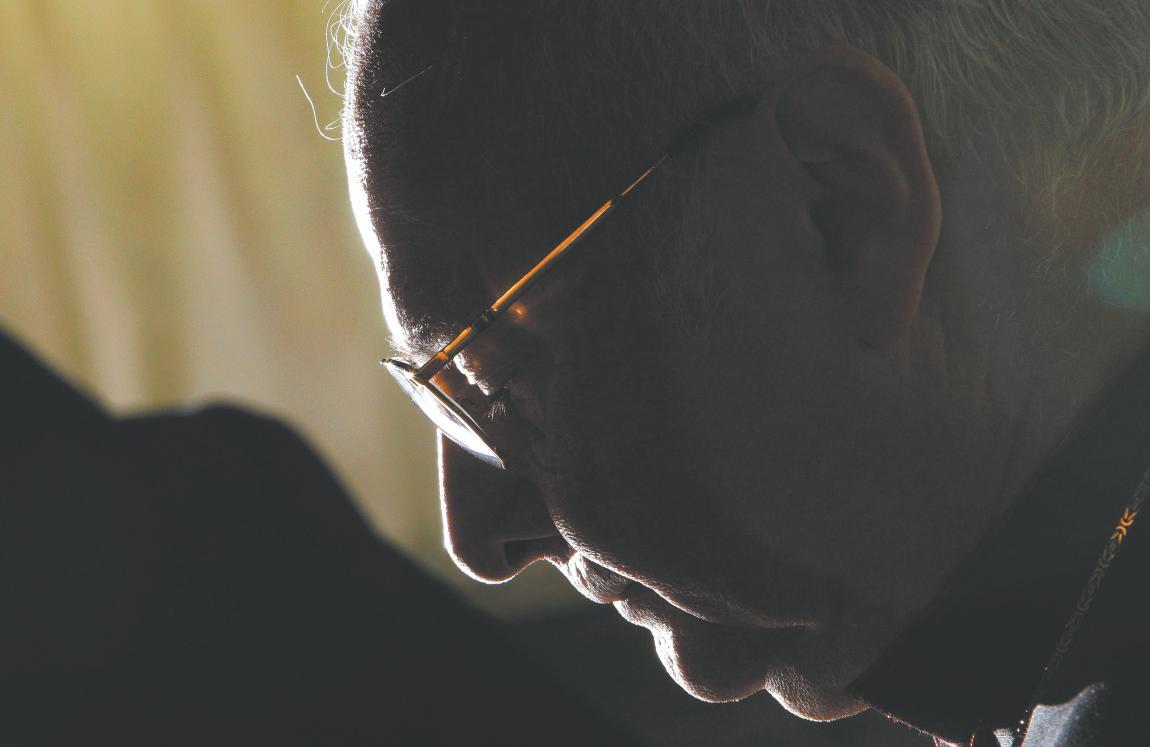
was not involved in the decision.
Pope Benedict was Archbishop of Munich and Freising from 1977 to 1982. The Archdiocese’s response came after the German daily newspaper Sueddeutsche Zeitung reported on the case in its 13 March edition.
The Archdiocese said no accusations of abuse were made against the priest, identified only as H, between February 1980 and August 1982 during his time in Munich.
The priest returned to ministry in nearby Grafing where he worked until early 1985 when new accusations of sexual abuse were made, the Archdiocese said.
On 29 January 1985, he was suspended from the priesthood and in 1986 he was convicted of sexually abusing minors, the Archdiocese said. He was sentenced to 18 months in jail, placed on five years probation, was fined about
$1,000 and ordered to undergo psychotherapy, according to the Archdiocese.
After the conviction, the priest worked in a nursing home between November 1986 and October 1987, the Archdiocese said.
He then worked in a parish in Garching/Alz - first as an assistant pastor and then pastor - until September 2008, according to the Archdiocese.
“The relatively mild sentence of the Ebersberg Court and the observations of the psychologists who treated him were decisive in his being sent back to parish work,” the Archdiocese said.
The Archdiocese also said the priest was relieved of his duties at the parish when Archbishop Reinhard Marx, who was installed in 2007, decided the priest should not remain in parish work.
He was assigned as a chaplain
at a resort and instructed to “do no further work with children, young people or altar servers,” the Archdiocese said.
The Archdiocese added that after the conviction, it was unaware of further incidents involving the priest. At the 12 March press conference, Archbishop Zollitsch said the German Bishops “are profoundly disturbed that this was possible within the church environment.”
He said that as cases came to light over the past several weeks, he had apologised to victims and said that “I would like to do that again here in Rome”.
Archbishop Zollitsch said the German Bishops “want to bring the truth to light ... even in cases from many years ago, because this is a right of the victims.”
He said the Bishops had compiled a “catalogue” of rules to deal
with such cases, including pastoral and therapeutic help for victims and their families; the appointment of a specific person in each diocese for victims to contact; the creation of a “culture of prevention” with guidelines for schools and church-related activities where children are present.
Full cooperation with civil authorities is part of the procedure, he said, with every case of suspected abuse subject to investigation by local law enforcement as well as Church authorities.
These investigations remain separate, he said, and the Church probe will not have influence over the civil one. Each diocese has been asked to fully investigate any claims of abuse or violence, even from long ago, he said.
The Pope has “explicitly given a favourable opinion of our catalogue,” he said.
The German Bishops’ set of guidelines is the most explicit and stringent so far, with the exception of the Church in Austria, he said
Asked whether these rules will be extended to the rest of the universal Church or suggested as guidelines, Archbishop Zollitsch said he did not know, but the Congregation for the Doctrine of the Faith, the Vatican office that deals with cases of priestly sexual abuse, was examining the possibility.
Archbishop Zollitsch said he had not discussed the recent claims of sexual abuse from the Diocese of Regensburg because he didn’t have enough information to broach the subject.
The cases are particularly sensitive because the claims involve alleged abuse at the choir school of the Regensburg Cathedral, where the Pope’s brother, Mgr Georg Ratzinger, served as choirmaster for 30 years.
The recent allegations involve incidents that occurred before Mgr Ratzinger began working there.
The Pope’s brother said he had not been aware of any sexual abuse but he has admitted that he slapped students on occasion.
ROME - The Vatican should prepare a document giving local Bishops and their tribunals a detailed procedure based on Canon Law for conducting their initial investigations of accusations of sexual abuse against a priest, said Archbishop Raymond L Burke, head of the Vatican’s supreme court.
Thanks to the media and to lawyers, the public has a mistaken impression that the Catholic Church’s Code of Canon Law is not capable of dealing effectively and decisively with accusations against priests, Archbishop Burke told a conference on the priesthood.
“One cannot help but observe, for example, that there already exists a universal norm - Canon
1722 - that contributes to the prevention of scandal and other dangers as a penal process is being carried out,” the Archbishop, Prefect of the Supreme Tribunal of the Apostolic Signature, said on 11 March.
The Canon he cited says: “To prevent scandals, to protect the freedom of witnesses, and to guard the course of justice, the Ordinary, after having heard the promoter of justice and cited the accused, at any stage of the process can exclude the accused from the sacred ministry or from some office and ecclesiastical function, can impose or forbid residence in some place or territory, or even can prohibit public participation in the Most Holy Eucharist.”
In 2001, the Vatican issued new norms for the way the Church handles sex abuse cases, requiring local Bishops to report probable cases of clerical sexual abuse against minors to the Congregation for the Doctrine of the Faith.
The doctrinal congregation can allow a local diocesan tribunal to handle the case under the
Congregation’s procedural rules or intervene and take up the case immediately in its own tribunal.
While the Vatican also has approved more detailed norms for the United States, Archbishop Burke said it would be helpful to present “the discipline of the universal Church in these matters, which is contained in the Code of Canon Law: the proper procedures to follow to investigate first the accusation of a delict (crime), and then to see if it is necessary to refer it to the Congregation for the Doctrine of the Faith” because there is evidence that a serious crime has been committed.
The document would outline “how you deal with an accusation itself,” determining whether or not a probable case of sex abuse exists and, therefore, must be referred to the Vatican, the Archbishop told Catholic News Service after his speech. “These kinds of accusations also happened in the past and there is a whole wisdom in the canonical tradition on how to deal with these things, obviously to protect the person who was
alleged to have been victimised, to protect the priest who is accused and to protect the whole Church,” he told CNS.
“The Church is quite prepared to deal with this; it has throughout the centuries, and what I am saying is that we have to make that discipline clear so that when cases happen, they can be dealt with,” he said in the interview.
“The Church, especially in its smallest and most defenceless members, has suffered a very serious wound because of the acts of abuse of minors committed by priests,” he said in his speech to the conference, which was sponsored by the Congregation for Clergy as part of the Year for Priests.
“The just remedy, the remedy that will protect and safeguard” all Church members and the Church itself “must be found in the canonical practice developed over the centuries and articulated in the current universal legislation,” Archbishop Burke told the priests. He was appointed Prefect of the Vatican’s supreme court in June 2008.

WARSAW, Poland - The brother of Pope Benedict XVI apologised to child victims of sexual abuse at his former school even though he said he was unaware of the alleged incidents.
“There was never any talk of sexual abuse problems and I had no idea that molestation was taking place,” Mgr Georg Ratzinger said, recalling his 30 years as choirmaster at the school that trains the elite boys’ choir of the Regensburg Cathedral.
His comments came during an interview with the German newspaper Neue Passauer Presse on 9 March. “I’m deeply sorry for anyone whose spiritual or physical integrity was injured by abuse,” said Mgr Ratzinger, who was choirmaster between 1964 and 1994.
“Today, such things are condemned even more because of greater sensitivities. I also condemn them, and simultaneously ask pardon from the victims.”
Mgr Ratzinger recalled that the priest who headed the school from 1953 until his death in 1992 had slapped boys in the face, but said he had not considered such punishments “particularly brutal.”
“If I’d known the exaggerated vehemence with which the director acted, I would have reacted,” Mgr Ratzinger told the newspaper in his native Bavaria.
“But at that time, it was the way of dealing with mistakes or the deliberate nonfulfilment of duties.
“I was happy when caning was totally banned in 1980, and I felt internally relieved.”
However, a former pupil at the school, Frank Wittenbrink, now a composer, told Germany’s Der Spiegel magazine that the teaching staff must have known about other forms of abuse. “There was a contrived system of sadistic punishments, connected with sexual desire,” said Wittenbrink, who graduated in 1967.
“The school leader chose two or three of us boys each evening from the dormitory and took us to his apartment, where he gave us wine and masturbated with minors. Everyone knew about this.”
The statements appeared as the president of the German Bishops’ conference, Archbishop Robert Zollitsch of Freiburg, prepared for a 12 March meeting with Pope Benedict to discuss the scandal
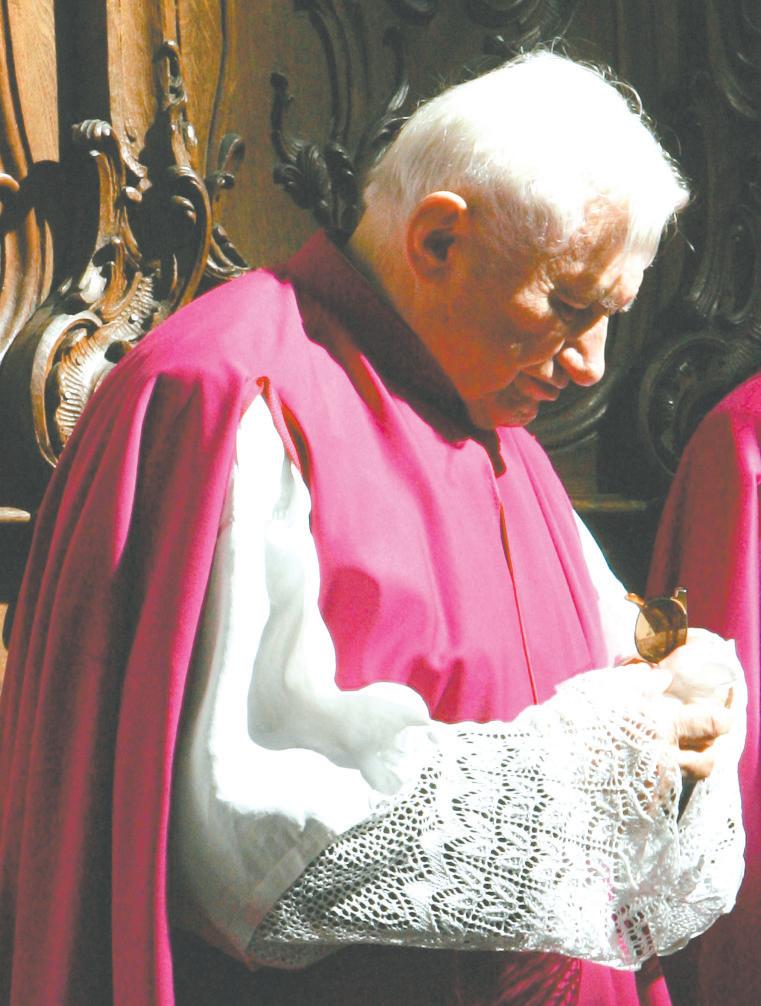
which erupted in late January.
Meanwhile, Bishop Stephan Ackermann of Trier, recently named to oversee abuse claims for the Church in Germany, welcomed an invitation from Germany’s minister for families, Kristina Schroder, to join a round-table discussion examining abuse beginning on 23 April.
Parent, teacher and trade union groups also will be represented.
“We ourselves have already said a meeting of all socially relevant groups would be very helpful,”
Bishop Ackermann said in an 8 March statement on the German Bishops’ conference website.
“The minister’s invitation is an important step toward the joint goal of speedily tackling this entire problematic issue.”
Abuse claims have been reported to date in at least 17 of the German Church’s 27 dioceses, with the most recent allegations surfacing on 8 and 9 March against Catholic institutions in Hildesheim, Dusseldorf and Limburg, as well as in Bavaria against a Franciscan Capuchin house at Burghausen and a Benedictine monastery at
Ettal. Speaking to journalists on 9 March, German Chancellor Angela Merkel praised the Church’s efforts to confront the accusations which include opening a hot line for victims and updating 2002 Church guidelines on abuse reporting.
The efforts indicated, she said, a “very serious wish to deal with the problems”.
However, Justice Minister Sabine Leutheusser-Schnarrenberger told the Suddeutsche Zeitung newspaper on 9 March that the Church also needed to “give a clear signal to the victims,” such as by suggesting “voluntary compensation” in case where legal claims had lapsed.
The press office of the German Bishops’ conference in Bonn declined to answer inquiries from CNS about abuse claims.
Bishops in neighbouring Austria and in the Netherlands also considered responses to abuse claims.
In Austria, Abbot Bruno Bauer of St Peter’s Abbey in Salzburg resigned on 8 March after he was accused of an act of abuse committed 40 years ago.
The Der Standard newspaper reported that an unnamed man-
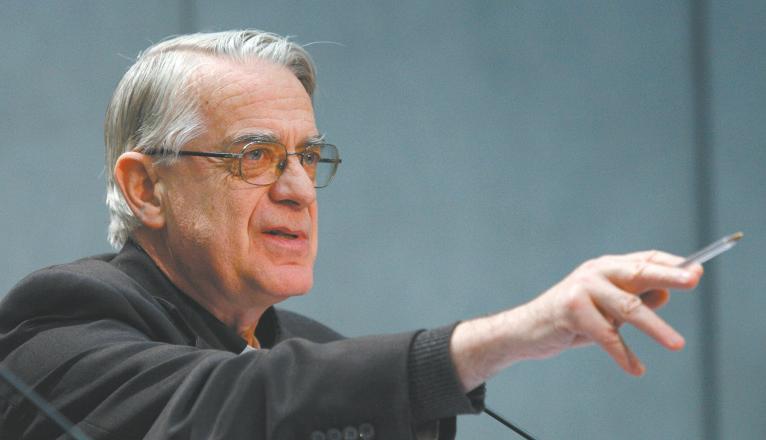
THE Vatican has released a statement defending Church responses to sex-abuse complaints and rejecting the charge by a German cabinet member that the Vatican was building a “wall of silence” on the issue.
Fr Federico Lombardi SJ, the director of the Vatican press office, said that Bishops in Germany, Austria and Holland had responded with “timely and decisive action” to recent reports of sexual abuse.
The Bishops in these countries had shown a “desire for transparency” by inviting abuse victims to come forward with their stories, he said.
“By doing so they have approached the matter ‘on the right foot,’ because the correct starting point is recognition of what happened and concern for the victims and the consequences of the acts committed against them.”
Fr Lombardi said that Church leaders in those countries would formulate new policies to guard against abuse in the future.
He recalled that Pope Benedict had recently met with the Bishops of Ireland to discuss the abuse problems there and would soon release a letter to the Irish Church on the subject.
The Vatican spokesman reserved his strongest language for the situation in Germany, where justice minister Sabine Leutheusser-Schnarrenberger had charged that the Vatican was building a “wall of silence” around the abuse problem.
contacted the ombudsman for the Salzburg Archdiocese about the incident in late 2009 after Abbot Bauer was elected to oversee the abbey.
Salesian Fr Herman Spronck, the most senior member of his order in the Netherlands, agreed on 1 March to investigate claims of child abuse at a monastery.
The Dutch Bishops’ conference announced an independent
Using virtually the same words, Fr Lombardi said that the 2001 Vatican policy on handling of sex-abuse cases is “sometimes improperly cited as the cause of a ‘culture of silence’.”
“Those who know and understand its contents are aware that it was a decisive signal to remind the episcopate of the seriousness of the problem, as well as a real incentive to draw up operational guidelines to face it.”
In Germany, he said, Church leaders have indicated their willingness to join in a national round table on the abuse issue, and “Chancellor Angela Merkel had justly recognised the seriousness and constructive approach shown by the German Church”.
Fr Lombardi issued a reminder that the Catholic Church has not been the only institution shaken by revelations of sexual abuse.
In Austria, for example, he noted that among 510 recent reports of abuse, only 17 have involved Church-related institutions.
“Certainly, the errors committed in ecclesiastical institutions and by Church figures are particularly reprehensible because of the Church’s educational and moral responsibility, but all objective and well-informed people know that the question is much broader, and concentrating accusations against the Church alone gives a false perspective,” he said.
inquiry on 9 March into allegations of sexual abuse of children by priests at Church schools and apologised to victims.
The inquiry follows reports of at least 200 accusations of abuse.
“The number of reports of abuse in former Catholic educational establishments requires further investigation,” the Bishops said after a meeting in the central city of Zeist.
VATICAN CITY - A greater presence of women in decisionmaking roles in the Church might have helped remove the “veil of masculine secrecy” that covered priestly sex abuse cases, a frontpage commentary in the Vatican newspaper said.
The article said that despite calls by Popes and others for welcoming women into equal, though diverse, roles in the Church, women have
generally been kept out of positions of responsibility.
As a result, the Church has failed to take advantage of the many talents and contributions that could have been provided by women, it said.
The article, published on 10 March by L’Osservatore Romano, was written by Lucetta Scaraffia, an Italian journalist and history professor who has been a frequent contributor to the Vatican paper in recent years.
As an example of what the
Church has lost by not taking advantage of women’s contributions, Scaraffia pointed to the “painful and shameful situations” of sexual abuse by priests against the young people entrusted to their pastoral care.
“We can hypothesise that a greater female presence, not at a subordinate level, would have been able to rip the veil of masculine secrecy that in the past often covered the denunciation of these misdeeds with silence,” the article said.
“Women, in fact, both Religious and lay, by nature would have been more likely to defend young people in cases of sexual abuse, allowing the Church to avoid the grave damage brought by these sinful acts,” it said. Scaraffia used the Italian word omerta, a term that refers to the Mafia’s code of silence, to describe the secrecy surrounding the sex abuse cases.
The article cited statements by Popes John Paul II and Benedict XVI in support of a greater presence of women in the Church, not
in the ordained priesthood but in roles that are important. The problem is that these theoretical statements have not been put into practice, it said. In reality, women continue to be generally excluded from decision-making roles in the Church, it said.
The article said Religious Orders have long understood better than other Church institutions the importance of reciprocal cooperation between men and women, as seen in the fact that most Orders have male and female branches.
VATICAN CITY (CNS) - Amid new disclosures of priestly sex abuse cases in Europe, including one in the German Archdiocese formerly headed by Pope Benedict XVI, the Vatican strongly defended the Church’s response to the crisis and said the Pope has led the effort to root out “filth” in the Church.
The Vatican statements came in the wake of hundreds of new sex abuse allegations against priests and other church personnel that have surfaced in recent weeks in Ireland, Germany, the Netherlands, Austria and Switzerland.
The Pope met with top German Bishops on 12 March and encouraged them to move ahead “with decision and courage” in investigating the widening scandal of sexual abuse of minors in Catholic schools, Archbishop Robert Zollitsch of Freiburg, the head of the German Bishops’ conference, told reporters.
Later the same day, the Vatican responded to a report that a German priest accused of sexually abusing a child had been allowed to return to pastoral work in the Archdiocese of Munich and Freising in the early 1980s, at the time Pope Benedict XVI was Archbishop there. The Vatican press office noted that the Archdiocesan official who had returned the priest to ministry had taken “full responsibility” for his “serious error,” and said the future Pope, then-Cardinal Joseph Ratzinger, was not involved in that decision. In 1985, three years after Cardinal Ratzinger had been called to serve as the Vatican’s chief doctrinal official, the same German priest faced new accusations of sexual abuse, and was eventually suspended from the priesthood and convicted in a civil court.
The revelations about the German case made headlines around the world and some commentators questioned how Cardinal Ratzinger could not have been aware of details of the situation at the time.
On 13 March, the Vatican countered by strongly defending the Pope against what it said was an aggressive campaign to drag him personally into the widening sex abuse scandal. “It is evident that over recent days some people have sought, with considerable persistence ... elements that could personally involve the Holy Father in questions of abuse. To any objective observer, it is clear that these efforts have failed,” Jesuit Fr Federico Lombardi, the Vatican spokesman, said in a written commentary.
The same day, the Vatican newspaper, L’Osservatore Romano, ran a front-page article under the headline: The severity of Benedict XVI against the filth in the Church
It said Pope Benedict was being mischaracterised as an aloof administrator with little interest in the scandal when, in fact, the German pontiff had led the way in addressing past cases and preventing new ones. “It is thanks to the greater severity of the Pope that various Bishops’ conferences are turning a light on cases of sexual abuse, and also cooperating with civil authorities so that justice is rendered to the victims,” it said.
In an unusual interview on 13 March, a key Vatican official

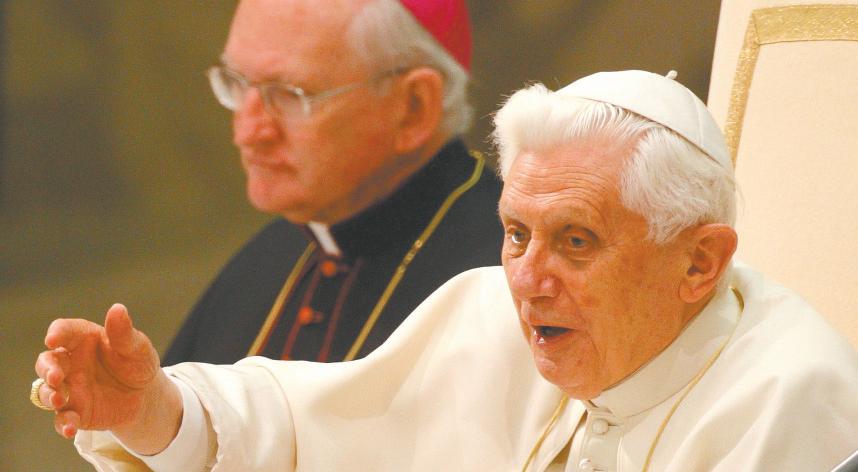
described in detail the steps taken by the Vatican to confront priestly sex abuse since 2001, the year the Congregation for the Doctrine of the Faith, under then-Cardinal Ratzinger, laid out strict new norms for processing such cases.
The official, Mgr Charles Scicluna, a doctrinal congregation official from Malta who deals directly with cases of priests accused of abuse of minors, told the Italian Catholic newspaper Avvenire that the allegation that Pope Benedict had covered up sex abuse crimes was “false and calumnious.”
L’Osservatore
Romano said Pope Benedict was being mischaracterised as an aloof administrator with little interest in the scandal, when in fact the German pontiff had led the way in addressing past cases and preventing new ones.
As head of the doctrinal congregation, he handled such cases with wisdom and courage and, as Pope, he has dismissed many priests from the clerical state, Mgr Scicluna said.
Mgr Scicluna also emphasised that the Vatican’s insistence on secrecy in the investigation of these cases by Church authorities does not mean Bishops or others are exempt from reporting these crimes to civil authorities.
“In some English-speaking countries, but also in France, if Bishops become aware of crimes committed by their priests outside the sacramental seal of Confession, they are obliged to report them to the judicial authorities,” he said.
“This is an onerous duty because the bishops are forced to make a gesture comparable to that of a father denouncing his own son.
“Nonetheless, our guidance in these cases is to respect the law.”
In countries where there is no legal obligation to report sex abuse accusations, Mgr Scicluna said, “we do not force Bishops to denounce their own priests, but encourage them to contact the vic-
tims and invite them to denounce the priests by whom they have been abused.”
Mgr Scicluna said that since the doctrinal congregation took over juridical control of the sex abuse accusations in 2001, it has processed about 3,000 cases, dealing with crimes committed over the last 50 years.
He said about 60 per cent of these cases involved sexual attraction towards male adolescents, 30 per cent involved heterosexual relations, and the remaining 10 per cent were cases of paedophilia, involving an adult sexual preference for pre-pubescent children.
Most cases of priestly sex abuse against minors have been handled without a Church trial because of the advanced age of the accused, and the penalty in such cases has usually been the imposition of strict limitations on the priest’s ministry, he said.
About 20 per cent of the cases resulted in a Church trial, with most of the accused found guilty (the conviction rate is about 85 percent overall). Punishment can range from restrictions or removal from ministry to dismissal from the priesthood.
In the most serious cases - about 10 per cent of the total - the Pope has dismissed the offender from the priesthood, and in another 10 percent the priest has been laicised at his request, Mgr Scicluna said.
He said the number of new cases of sex abuse by priests has declined; last year there were 223 cases reported from around the world. And while the majority of the 3,000 or so cases handed by the Vatican since 2001 have been from the United States, by last year US cases had dropped to about 25 percent of the total.
The trend is toward a growing number of countries reporting cases, but a drop in the overall number of accusations, he said.
Mgr Scicluna said that in Italy, “the phenomenon (of priestly sexual abuse of minors) does not seem to have dramatic proportions, although what worries me is a certain culture of silence which I feel is still too widespread in the country.”
Like others at the Vatican, Mgr Scicluna noted that a very small minority of the world’s 400,000 priests were sexual perpetrators, which he said “does not correspond to the perception that is created when these sad cases occupy the front pages of the newspapers.”
VATICAN CITY - Vatican officials are concerned that the Church’s longstanding insistence on confidentiality in its treatment of priestly sexual abuse cases is being misinterpreted as a ban on reporting serious accusations to civil authorities.
As past episodes and accusations of abuse have come to light recently in Germany, Austria and the Netherlands, media attention has focused in part on what kind of guidance or instructions local Bishops received from the Vatican on how to handle such cases.
An increasingly widespread impression - and a mistaken one, Vatican officials say - is that Pope Benedict XVI himself, when he headed the Vatican’s doctrinal congregation, ordered Bishops not to inform civil authorities about accusations of sexual abuse by priests.
The issue surfaced on 8 March when Germany’s justice minister, Sabine LeutheusserSchnarrenberger, said that as Cardinal Joseph Ratzinger, the Pope had in 2001 written a directive that said serious sex abuse cases “are not supposed to be divulged outside the Church.”
The minister’s reference was to the 2001 document De delictis gravioribus (“On more serious crimes”) which gave the Congregation for the Doctrine of the Faith juridical control over how the Church handles cases of sexual abuse of minors by priests.
It was seen inside the Vatican as an important tool in making sure perpetrators were discovered and brought to justice.
But much media attention has focused on the fact that the 2001 document said such cases were covered by “pontifical secret,” which meant they would be handled in strict confidentiality. Critics saw that as a way for the Church to hide accusations from civil authorities.
Vatican officials said it was
important for people to know that the confidentiality imposed on the Church’s internal handling of abuse cases does not exempt Bishops or others from reporting serious facts and accusations to civil authorities.
They emphasised that the Vatican document dealt with how Church law treats such cases, not as a substitute for civil law, which deals with the crime separately.
“The purpose of ‘pontifical secret’ here was to respect the rights of the accused and of the witnesses, including the victim, to confidentiality,” said one informed Vatican official. He said civil law often has similar provisions to protect confidentiality when a potential crime is under investigation.
“But this is an ecclesiastical law. It does not affect the duty to obey civil law,” he added.
The official said the Vatican has never given Bishops directives against cooperation with competent civil authorities.
On the contrary, he said, the Vatican expects local Bishops to comply with laws that mandate reporting of sex abuse allegations.
For example, the US Bishops’ norms on sexual abuse, which were revised and approved by the Vatican in 2002, stated clearly: “The diocese/eparchy will comply with all applicable civil laws with respect to the reporting of allegations of sexual abuse of minors to civil authorities and will cooperate in their investigation.”
In many cases, civil law mandates that Church authorities report such allegations.
But even as the Vatican has made it clear that Bishops are not above the law, it has not encouraged local Bishops to act as volunteer reporting agents for the state every time an accusation of sexual abuse is made.
Cardinal Claudio Hummes, head of the Congregation for Clergy, said in a recent interview that instances of sexual abuse by priests were “criminal facts” as well as serious sins, and require cooperation with the civil justice system.
“Once the evil deed has been objectively proven, one must resolutely pursue (the case) to the very end by also turning to ordinary justice,” he said.
in brief...
Sri Lanka’s leading prelate has founded the first Christian monastery in his largely Buddhist nation. Archbishop Malcolm Ranjith of Colombo, who served as secretary of the Congregation for Divine Worship and Discipline of the Sacraments from 2005 to 2009, has erected a diocesan institute of contemplative life whose initial members are one Austrian and three Sri Lankans from Heiligenkreuz Abbey in Austria.
The Cistercian abbey, renowned for its fidelity to the Magisterium and its celebration of the ordinary form of the sacred liturgy in Latin, has more monks than at any time since the Baroque era. If the new diocesan institute succeeds, it will one day become part of the Cistercian Order, according to Heiligenkreuz’s Abbot.
ATTORNEYS representing an alleged former lover of Fr Marcial Maciel and her children have severed ties with the family because their recent public accusations differed “in some substantial points” from what the attorneys had previously been told. Blanca Estela Lara Gutierrez claimed last week that the founder of the Legionaries of Christ fathered two children with her, and her sons claimed that Fr Maciel sexually abused them.
In January, the woman’s eldest son asked for US$26 million from the Legionaries of Christ in return for silence, according to a press release issued by the Religious Order.
After being directed by the Vatican in 2006 to withdraw from public life and spend his final years in “penitence and prayer,” Fr Maciel died in 2008 at the age of 87.
Bishop Denis Brennan of Ferns, Ireland - who last week asked the faithful to help pay for sex-abuse settlements - has said that no money from parish collections will be used for that purpose. Settlement costs will be met with the help of special donations and a new mortgage on the diocesan headquarters, he said.
“No monies from parish collections have been used to date to fund the payment of compensation claims as have been agreed, and no plans are either in place - or envisaged - where future claims would be funded from these sources.”
JAPAN has a skyrocketing suicide rate. The Apostolic Nuncio there, Archbishop Alberto Bottari de Castello, told L’Espresso that he thinks the acceptance of suicide reflects the absence of faith.
He explained: “When a Christian arrives at the decision to take his life, he knows that he is about to violate a sacred law: life was given to him by God, and only God can take it away.
“The Japanese tempted by suicide does not have this obstacle. He does not have the concept of sin. He has no-one, he has nothing, beyond his own material and cultural world, to ask for help.”
Gender ideology has harmed, not helped, women: Vatican envoy to UN
THE Vatican’s representative at the United Nations has denounced gender ideology, saying that the approach has harmed rather than helped women.
Speaking at a UN session on gender equality on 8 March, Archbishop Celestino Migliore said that the gender ideology “is proving increasingly ideologically driven, and actually delays the true advancement of women”.
The gender approach, the Archbishop said, seeks to “dissolve every specificity and complementarity between men and women”.
Moreover, the documents produced by UN conferences in recent years have often ascribed “to a notion of sexual and reproductive health and rights which is violent to unborn human life and is detrimental to the integral needs of women and men within society,” he said.
Archbisop Migliore acknowledged that women “continue to suffer in many parts of the world” because of unjust discrimination and “violence in the form of female feticide, infanticide, and abandonment”, as well as “discrimination in health and nutrition”.
He noted, moreover, how “girls and

women 15 years of age and over account for two-thirds of the world’s illiterate population”.
“It is a sad fact that three quarters of those infected by HIV/AIDS are girls and women between the ages of 15 and 24” and that, among the victims of human trafficking, “minors account for up to 50 per cent and approximately 70 per cent are women and girls”. The solution, however, is not to impose an artificial equality that disregards the true dignity of womanhood, he insisted.
“A solution respectful of the dignity of women does not allow us to bypass the right to motherhood,” the Vatican envoy said, “but commits us to promoting motherhood by investing in and improving local health systems and providing essential obstetrical services.”
Archbishop Migliore stressed the fact that the final documents of international conferences and committees often “link the achievement of personal, social, economic and political rights to a notion of sexual and reproductive health and rights which is violent to unborn human life and is detrimental to the integral needs of women and men within society”.
“Fifteen years ago the Beijing Platform for Action proclaimed that women’s human rights are an inalienable, integral and indivisible part of universal human rights,” he said.
“This is key not only to understanding the inherent dignity of women and girls but also to making this a concrete reality around the world.”
The Archbishop was addressing the 54th session of the Economic and Social Council’s Commission on the Status of Women, which was meeting to discuss “Item 3: Follow-up to the Fourth World Conference on Women and to the 23rd special session of the General Assembly entitled Women 2000: gender equality, development and peace for the twenty-first century”.
DENVER (CNS) - The decision to refuse re-enrolment at a Boulder Catholic school to two children of lesbian parents was the only outcome that was fair to the children, their teachers, school parents and “the authentic faith of the Church,” said Denver Archbishop Charles J Chaput.
“Our schools are meant to be ‘partners in faith’ with parents,” the Archbishop said in a column published in the 10 March issue of the Denver Catholic Register, the Archdiocesan newspaper. “If parents don’t respect the beliefs of the Church, or live in a manner that openly rejects those beliefs, then partnering with those parents becomes very difficult, if not impossible. It also places unfair stress on the children, who find themselves caught in the middle, and on their teachers, who have an obligation to teach the authentic faith of the Church.”
Archbishop Chaput, whose Archdiocese includes Boulder, was commenting on the case of two children whose parents, a lesbian couple, were enrolling them at Sacred Heart of Jesus School.
The couple was told that their older child, who was being enrolled for kindergarten next year, could attend kindergarten but could not continue into first grade after that. The younger child could be enrolled in preschool for next year but could not continue into kindergarten the following year, school officials said.
The primary purpose of Catholic schools, the Archbishop said, is “to form students in Catholic faith, Catholic morality and Catholic social values.” But he said that did not mean the schools only accept Catholic students with married parents.
“Many of our schools also accept students of other faiths and no faith, and from single-parent and divorced-parent families,” he said. “These students are always welcome so long as their parents support the Catholic mission of the school and do not offer a serious counterwitness to that mission in their actions.” Archbishop

Chaput said Archdiocesan policy on school admissions “was followed faithfully” by the staff at Sacred Heart of Jesus School.
The policy reads in part: “Parents living in open discord with Catholic teaching in areas of faith and morals unfortunately choose by their actions to disqualify their children from enrolment. To allow children in these circumstances to continue in our school would be a cause of confusion for the student in that what they are being taught in school conflicts with what they experience in the home.”
Fr Bill Breslin, pastor of Sacred Heart of Jesus Parish, had a similar message in a 5 March note to parishioners and school parents. “If a child of gay parents comes to our school, and we teach that gay marriage is against the will of God, then the child will think that we are saying their parents are bad,” Fr Breslin said.
“We don’t want to put any child in that tough position - nor do we want to put the parents, or the teachers, at odds with the teachings of the Catholic Church.”
Archbishop Chaput noted in his column that “the Church does not claim that people with a homosexual orientation are ‘bad,’ or that their children are less loved by God.
Quite the opposite. But what the Church does teach is that sexual intimacy by anyone outside marriage is wrong; that marriage is a sacramental covenant; and that marriage can only occur between a man and a woman”.
Fr Breslin said he did not understand why “good parents (would) want their children to learn something they don’t believe in. There are so many schools in Boulder that see the meaning of sexuality in an entirely different way than the Catholic Church does,” he added. “Why not send their child there?”
Marianne Duddy-Burke, executive director of Dignity USA, which describes itself as an organisation of gay, lesbian, bisexual and transgender Catholics but has no official Church status, said in a statement that the school’s decision “cannot be understood as anything other than discrimination on the back of a child.”
“The Archdiocese has chosen to selectively enforce Catholic rules about families while trampling on core Catholic values of compassion, equality and love,” she added. “This is tragic for the family involved and for all who turn to Church officials for moral guidance.”
All should offer their bodies and blood at Mass: preacher explains uniqueness of Christ’s Sacrifice and our participation
VATICAN CITY (Zenit.org)
- What makes Christ the Priest unlike any other priest, either from the Old Testament or from any other cult, is that His priestly sacrifice is He, Himself.
But that uniqueness is also the calling shared by priests and laity, to “imitate that which is celebrated” every day at Mass.
This was the reflection offered on 12 March by Capuchin Fr Raniero Cantalamessa, preacher of the Pontifical Household, in his second Lenten sermon of the year, given in the presence of Benedict XVI and the Roman Curia.
The Capuchin is focusing his homilies on the priesthood in this Year for Priests. In Advent, he meditated on the priest as servant of Christ, in the power and the unction of the Holy Spirit. During Lent, he is looking at the priest as steward of the mysteries of God.
“To be a priest ‘according to the order of Jesus Christ,’ the presbyter must, like Him, offer himself,” Fr Cantalamessa said.
“On the altar, he does not only represent the Jesus [who is] ‘high priest,’ but also the Jesus [who is] ‘supreme victim,’ the two things being, moreover, inseparable. In other words, he cannot be content

to offer Christ to the Father in the sacramental signs of bread and wine, he must also offer himself with Christ to the Father.”
The preacher shared his own experience of this sacrifice: “As a priest ordained by the Church, I pronounce the words of the consecration ‘in persona Christi,’ I believe that, thanks to the Holy Spirit, they have the power of changing the bread into the body of Christ and the wine into His blood; at the same time, as a member of the body of Christ [...] I look at the brethren before me or, if I celebrate on my own, I think of them whom I must serve during the day and, turning to them, I say mentally together with Jesus: ‘Brothers and sisters, take, eat, this is my body; take, drink, this is my blood.’”
Fr Cantalamessa clarified that this mutual offering is necessary.
“The offering of the priest and of the whole Church, without that of Jesus, would neither be holy nor acceptable to God, because we are only sinful creatures,” he said, “but Jesus’ offering, without that of His body which is the Church, would also be incomplete and insufficient: not, be it understood, to procure salvation, but because we receive it and appropriate it.
“It is in this sense that the Church can say with St Paul: ‘in my flesh I complete what is lacking in Christ’s afflictions’.”
And the preacher offered a simple example to illustrate his point.
“Let us imagine,” he said, “that in a family there is one child, the first born, most devoted to the
father. He wishes to give him a present for his birthday. However, before presenting it to him he asks all his brothers and sisters secretly to add their signature on the gift.
“It then arrives in the hands of the father as the indistinct homage of all his children and as a sign of the esteem and love of them all but, in reality, only one has paid its price. And now the application. Jesus admires and loves the heavenly Father. He wishes to give Him every day, until the end of the world, the most precious gift He can think of, that of His life itself.
“In the Mass He invites all His ‘brothers,’ who we are, to add their signature on the gift, so that it reaches God the Father as the indistinct gift of all his children. But, in reality, we know that only one has paid the price of such a gift. And what a price!”
Fr Cantalamessa proposed that laypeople, too, are called to offer themselves with Christ in the Mass.
“Let us try to imagine what would happen if also the laity, at the moment of the consecration, said silently: ‘Take, eat, this is my body. Take, drink, this is my blood,’” he proposed.
“A mother of a family thus celebrates her Mass, then she goes home and begins her day made up of a thousand little things. But what she does is not nothing: It is a Eucharist together with Jesus.
“A [Religious] sister also says in her heart at the moment of consecration: ‘Take, eat ...’; then she goes to her daily work: children, the sick, the elderly. The Eucharist ‘invades’ her day which becomes a prolongation of the Eucharist.”
Model for policymakers seen in encyclical’s focus on truth, justiceBY BETH GRIFFIN Catholic News Service
UNITED NATIONS - Pope Benedict XVI’s encyclical Caritas in Veritate, while not intended to be a treatise on economics, offers a framework for solving the current financial crisis, according to panellists at a 10 March UN event.
The encyclical’s focus on truth, trust and social justice is a model for policymakers to consider, they said. Their presentations addressed globalisation in the context of the encyclical.
The event was sponsored by the Vatican’s UN mission and the Path to Peace Foundation and coincided with the 54th session of the UN Commission on the Status of Women.
“With this document,” said Archbishop Celestino Migliore, Papal Nuncio to the United Nations, “Pope Benedict writes to us not as a politician, or an expert in finance and economy, but as a man of faith trying to read the signs of the times in light of God’s wisdom; not to give out recipes and solutions, but to shed light on different human situations and help people make sense of and find hope and the necessary resilience to confront new situations and events.”

that the pursuit of self-interest in the marketplace leads to economic efficiency and the well-being of society is not valid. Those who relied on it allowed governments to abrogate their responsibility to protect the vulnerable, he said.
Government and civil societies must play a role alongside the economic markets, he said. “Governments will not solve all the problems and can not stop all bad behaviours,” Stiglitz said, but they must enact simple rules to protect individuals.
Stiglitz said there were “aspects of moral depravity” in the conduct of some people in the financial sector who engaged in practices that were “unethical but not illegal.”
Assigning blame is not productive, she said. “An unfettered search of ‘what went wrong’ with a true zeal to find out the truth - the veritas - places us in the wisdom of the Pope’s encyclical,” she said. Boroff said the most resonant element in Caritas in Veritate (“Charity in Truth”) is that “without truth, without trust and love for what is true, there is no social conscience and responsibility, and social action ends up serving private interests and the logic of power, resulting in social fragmentation, especially in a globalised society at difficult times like the present.”
VATICAN CITY - Priests are called to be prophets, especially today in a world that acts as if God doesn’t matter and as if fidelity were either impossible or an attack on personal freedom, Pope Benedict XVI told more than 550 priests, Bishops and Cardinals.
“In his way of thinking, speaking, judging what happens in the world, serving and loving, relating to others, even in his dress, the priest must draw prophetic strength from his sacramental belonging” to Christ, the Pope said.
Pope Benedict met at the Vatican on 12 March with participants in a two-day theological conference on the priesthood which was sponsored by the Congregation for Clergy as part of the Year for Priests.
The Pope said that too many people, including priests themselves, equate a priest’s identity with the functions he carries out in the Church and the world, “almost like a social worker”.
But when he receives the Sacrament of Holy Orders, a man’s very being changes and he becomes part of the one priesthood of Jesus Christ, the Pope said. “The men and women of our time ask us only to be priests to the depths. The lay faithful can have their human needs met by many others,” he said, but it is only from the priest that they can receive the word of God, the sacramental forgiveness of sins and the Eucharist.
It is the priest’s identity, not his function that has led the Latin-rite Church to require and the Eastern Catholic Churches to recommend that priests be celibate, he said.
“Sacred celibacy,” he said, is “an authentic prophecy of the kingdom, sign of consecration with an undivided heart to the Lord and to the things of the Lord, (and) an expression of the gift of oneself to God and to others.”
Joseph E Stiglitz said the crisis is taking a toll on people all over the world, but it “has a ‘Made in USA’ label on it.”
“We exported the deregulatory philosophy that created the crisis and allowed it to move quickly around the world,” he said, “but we also exported our toxic mortgages,” which were purchased largely by Europeans.
Stiglitz, a Nobel laureate, is a professor at Columbia University and Chair of the UN Commission of Experts on Reforms of the International Financial and Monetary System.
He said economist Adam Smith’s long-dominant philosophy
As an example, he cited predatory lending in the credit card market. He said banks that charge 30 per cent annual interest are abusive, violate religious dictums against usury and prey on poor people “because that’s where the profits are.”
The basic values of truth and honesty were ignored by the financial sector, leading to the undermining of trust throughout society, said Stiglitz. “The silver lining on the cloud of our crisis is it has brought about a re-examining of the way our society and economy functions,” he said.
Karen E Boroff, Dean of the Stillman School of Business at Catholic-run Seton Hall University in South Orange, New Jersey, said Caritas in Veritate inspires an honest search for the root causes of the financial crisis as a basis for a successful solution.
She said just and moral people search for truth and not expedient answers and should be more earnest in probing “what has given rise to the economic crisis.”
“If we hope to have any economy operate with distributive and social justice,” Boroff said, “it has to have honest people at every juncture, and not just those at the top.”
She said the encyclical promotes the principle of subsidiarity - “that matters should be handled by the lowest level of competent people, because that fosters efficiency, effectiveness and, in the Pope’s words, is well-suited to manage globalisation and directing it toward authentic human development”.
Subsidiarity was violated when people distanced themselves from the financial instruments they created and relied on mathematical models that offered a false sense of security, she said.
The modern world, which “progressively is excluding God from the public sphere,” has a hard time accepting someone dedicated to the sacred, someone “taken from the world in order to intercede on behalf of the world,” the Pope said.
Priests today must “speak of God to the world and present the world to God,” he said. “Today, the most necessary prophecy is that of fidelity which, starting from Christ’s fidelity to humanity, passing through the Church and the ministerial priesthood, leads him to living his priesthood in total adhesion to Christ and the Church,” the Pope said.
Pope Benedict said that in many ways priesthood “remains a great mystery, even for those of us who have received the gift. Our limits and our weaknesses must lead us, with profound faith, to live and protect this precious gift with which Christ has configured us to Himself, making us participants in His saving mission”.
Panorama entries must be in by 12pm Monday.
Contributions may be emailed to administration@therecord.com.au, faxed to 9227 7087, or mailed to PO Box 75, Leederville WA 6902.
Submissions over 55 words will be edited. Inclusion is limited to 4 weeks. Events charging over $10 will be put into classifieds and charged accordingly. The Record reserves the right to decline or modify any advertisement.
THURSDAY, 18 MARCH
Mary MacKillop 2010 Special Masses
7pm at Sisters of St Joseph’s Chapel, 16 York Street, South Perth. Honouring Blessed Mary MacKillop in the year of the Canonisation at the Vigil Mass of the feast St Joseph followed by supper. Everyone welcome. Enq: Sr Maree 0414 683 926.
FRIDAY, 19 MARCH - SUNDAY, 21 MARCH
Weekend of Prayer and Reflections
7.30pm at the Little Sisters of the Poor, 2 Rawlins St, Glendalough. Presented by Fr Don Kettle, for all young girls aged 18-35 years old, a wonderful opportunity of giving a little bit of your precious time to the Lord. RSVP before Wednesday, 10 March to Sr Veronika: 9443 3155 or community.perth@lsp.org.au.
Separated, Divorced, Widowed
7pm at Epiphany Retreat Centre, Rossmoyne. Beginning Experience is running a weekend programme designed to assist and support people in learning to close the door gently on a relationship that has ended in order to get on with living. Enq: Helen 9246 5150 or Maureen 9537 1915.
Immaculate Conception Curia, Fremantle
Legion of Mary Acies Ceremony 2pm at St Jerome’s Parish Church, Troode St, Munster. Parish Priest and Spiritual Director, Fr Johnson Malayil; Homily delivered by Fr Noel FitzSimons. All Spiritual Directors, active and auxiliary members, family, friends and parishioners most welcome. Tea will be provided. Enq: 9586 4134 or 0423 230 755.
Dominican Laity of Our Lady of the Rosary
2pm at St Catherine’s Convent, 31 Williamtown Rd, Doubleview. Visitors welcome. Enq: Jeff 9446 3655.
SATURDAY, 20 MARCH
A Morning Retreat
9am to 12noon at Multi Purpose Room, John XXIII College. Murray Graham, Inigo Centre Director presents, Inner Peace. Cost, donation for Inigo Centre. Enq: Murray, 9383 0444.
SUNDAY, 21 MARCH
Meditative Prayer in the Taize Style
7pm to 8pm at Sisters of St Joseph Chapel, 16 York Street, South Perth. Time to be still with God speaking to your heart through listening to the sacred Scripture, singing the chants from Taize in a beautiful candlelit Chapel in silence and prayer. Chapel doors open at 6.30pm. All welcome. Enq: Sr Maree Riddler 0414 683 926.
Taize Prayer Evening
7pm to 8pm at St. Lawrence, Balcatta. Spend an hour listening to simple music, canons, and short readings from the Scripture, intercession prayer and reflect on the mercy of God in silence. Later talk on Forgiveness. Enq: Fr Irek or Parish Office 9344 7066.
FRIDAY, 26 MARCH
Medjugorje Evening of Prayer
7-9pm at St Aloysius Parish, 84 Keightley St, Shenton Park. An evening of prayer with Our Lady Queen of Peace consisting of Adoration, Rosary, Benediction, Reconciliation concluding with Holy Mass. Free DVD on Fr Donald Calloway. All warmly welcome. Enq: Eileen 9402 2480.
SATURDAY, 27 MARCH
Day of the Unborn Child
1pm at St Mary’s Cathedral, Victoria Square. Holy Mass, including procession with flowers, principal celebrant Archbishop B J Hickey, followed by a Holy Hour led by Rev Fr Paul Carey SSC. All are earnestly invited to celebrate the sacredness of every human life and pray for an end to abortion. Enq: Lydia 9328 2926.
Passion of Christ Meditation - Commemorating Holy Week
7.30pm at St Joseph’s Church, 20 Hamilton Street, Bassendean. Youth Outreach Group RADIX DVD performance from World Youth Day and National Youth Day, superb presentation following Saturday night Vigil Mass. All welcome.
Saturday, 27 March
Novena Devotions – Our Lady of Good Health, Vailankanni 5.30pm at Holy Trinity Church, 8 Burnett Street, Embleton. 6pm Vigil Mass. Enq: George 9272 1379.
SUNDAY, 28 MARCH
World Youth Day - Festival 2010
12pm to 4pm at Forrest Place, Perth City. Free WYD celebration with live music from Flame, Apokalypsis, Youth Impact, African Choir, and great entertainment from Fr Hong Pham, Br Gabriel and much more. Open to all ages. Bring your flags, WYD shirts, free hugs signs and the WYD
spirit. Enq: www.cym.com.au or call 9422 7912.
TUESDAY, 30 MARCH
Day of Reflection (MMP)
10.30am at St Bernadette’s Catholic Church, Glendalough. Rosary Cenacle, followed by Holy Mass and talks, Celebrant and Speaker, Fr Ronan Murphy, visiting Priest from the United States and Ireland. BYO lunch to share. Tea and coffee provided. Enq: 9341 8082.
WEDNESDAY, 31 MARCH
Healing Mass
7pm at Ss John and Paul Church, Willetton. Praise and Worship followed with Healing at 7.30pm organised by the John Paul Prayer Ministry. Fr Roy Pereira will be the celebrant. Worship, come and be touched and blessed by the Power of the Holy Spirit. Enq: Michelle 9456 4215.
FRIDAY, 2 APRIL
Good Friday Service
10.30am at Catholic Agricultural College, Bindoon. Confessions, followed at 11am by the Stations of the Cross and confessions continue. 2.30 pm, Solemn ceremony, The Lord’s Passion. All are welcome! Enq: Fr Paul 9571 1839 or CAC 9576 1040.
SUNDAY, 4 APRIL
Easter is Coming
2pm at Russell Square, James St, Northbridge. In our ever increasingly secular world, the real meaning of Easter is getting lost. Come and remind the people of Perth what Easter is about. Join with hundreds of Christians from many different denominations to come together to celebrate the real Easter, man and God reconciled and together we are one. Enq: awakeningwa@ fusion.org.au or 08 9472 3470.
Easter Sunday - Taize Worship
7pm at Anglican Catholics (TAC), 11 Susan Street, Maylands. Enq: 0417 180 145. www.tradanglican.iinet.net.au
SATURDAY, 10 APRIL
Sand Sculpture Competition
9am to 1.30pm at Scarborough Beach. Have fun in the sun and help promote WYD 2011. Youth Groups and Communities encouraged to put a team together to get creative in the sand and join in the fun activities. Great prizes, high profile judges, beach games and bring your own picnic. Download registration form, www.cym.com. au or 9422 7912.
SUNDAY, 11 APRIL
The Feast of Divine Mercy 3-6pm at Holy Family Church, Lot 375, Alcock St, Maddington. The programme includes Reconciliation, Divine Mercy Chaplet and Novena, Eucharistic Adoration, Holy Mass, healing prayers. To be preceded by a Novena to the Divine Mercy from 2-10 April every day from 3-4pm. Inviting all faithful to know more about Divine Mercy through the sharing of the word on all 10 days. Enq: 9493 1703.
Feast of Divine Mercy 1.30-2.30pm at St Mary’s Cathedral, Victoria Sq, Perth. Holy Rosary, and the Chaplet of Divine Mercy prayers followed from 2.30-3.30pm with Holy Mass, Main Celebrant Fr Alfonsas Savickis. All priests are welcome to concelebrate. Benediction and Veneration of First Class Relics of St Faustina Kowalska. Refreshments later. Enq: 9457 7771.
MONDAY, 12 APRIL - THURSDAY, 22 APRIL
National Pilgrimage 2010 - In the Footsteps of Mary MacKillop Enq: Laura lmccarthy@sosjwa.org.au.
SATURDAY, 17 APRIL
St Padre Pio Pilgrimage 8am depart, pickup points for Bullsbrook. 9.30am Station of the Cross, 11am Holy Mass, Bindoon. BYO lunch, tea and coffee provided. 2pm, Gin Gin, Procession, Rosary, Adoration, Divine Mercy and Benediction. 3.45pm return Perth. Transport, $15. Enq: Midland, Catrina 9255 1938; Bassendean, Ivana 9279 7261; Morley, Christine 9276 3264; Leederville, Leena 9444 3617; Balcatta, Rosa 9276 1952; Glendalough, Des 6278 1540; St Joachim, Mirrabooka, Girawheen, Nita 9367 1366.
SUNDAY, 18 APRIL
April Sunday Sesh 6pm at St Francis Xavier Parish, 279 Forrest Road, Armadale. Mass, followed by Sesh at 7.15pm. Open for youth of all ages 15-35). Guest Speaker, Fr Robert Cross, presenting, The Truth Matters, Authority in the Church. The night includes music, activities, prayer time and group discussions. Bring money for supper. Enq: www. cym.com.au or 9422 7912.
MONDAY, 17 MAY - FRIDAY, 28 MAY
Tour of the Holy Land
12 day tour with Fr Roy Pereira visiting Sea of Galilee, Jericho, Masada, The Dead Sea, Bethany, Jerusalem and Cana. For cost, itinerary and more details, please contact: Francis Williams (Coordinator) T: 9459 3873 M: 0404 893 877 Email: francis@perthfamily.com.
GENERAL NOTICES
Book of Remembrance
St Brigid’s College Lesmurdie. For students, Sisters and staff members of St Brigid’s College, Lesmurdie who have gone to their eternal rest. If you know of loved ones, friends or acquaintances who have passed away and who attended or worked at St Brigid’s, please contact Jenny Lewis 92918129 or cream.annamaria@stbrigids.wa.edu. au for inclusion in the Book of Remembrance to be placed in the College Chapel.
Perpetual Adoration
Perpetual Adoration of the Blessed Sacrament is in its seventh year at Christ the King Church, Beaconsfield. Open 24 hours, except at Mass times. All welcome. Enq: Joe 9319 1169.
Pilgrimage to the Holy Land
The Church of St Jude in Langford is seeking to put together a visit to Jordan, the Holy Land and Egypt, leaving mid-August 2010. Expect the pilgrimage to be for circa 19 days and could accommodate 28-30 people. Fr Terry Raj will be the Spiritual Director. Enq: Matt 6460 6877, mattpicc1@gmail.com.
St Paul’s Mt Lawley - Lenten Services
Weekday Masses, 7.45am and 5.45pm. Stations of the Cross and Benediction, Fridays 6.15pm. Wednesday Fasting and Almsgiving Supper, any time between 5-6.45pm in the church undercroft. 9.30-10.30am, Wednesdays Bible study on St Paul and the Power of the Cross in the RSL Chapel, and 7-8pm in the church undercroft.
EVERY SUNDAY IN LENT
Bible Study Introduction
3-4pm at St Joseph’s Parish Centre, 20 Hamilton St, Bassendean. A Bible in hand is better than two on the shelf. Become Bible friendly. 4-5pm Church History at a Glance. Appreciation of the heritage of the Catholic Faith in the Third Millennium looking at the Church’s providential pathway through history.
Extraordinary Rite Latin Mass
11am at St Joseph’s Church, 20 Hamilton St, Bassendean.
EVERY TUESDAY IN LENT
Lenten Tuesday Prayer Meetings
7pm at St Mary’s Cathedral Parish Centre, 450 Hay St, Perth. Join us with others in prayer for personal healing and overcoming the burdens of life united with Our Lord and Our Lady. Weekly live the heritage of the Faith in Sacred Scripture, the Holy Rosary, praise in song, and reflection. Prayer is life’s spiritual lifeline.
EVERY THURSDAY IN LENT
Catholic Questions and Answers
7-7.30pm at St Joseph’s Parish Centre, 20 Hamilton St, Bassendean. Catecheses easily learned with questions and answers. Catechism of the Catholic Church, with Fr John Corapi DVD series. Adult learning and deepening of the Catholic Faith from 7.30-9pm.
EVERY SUNDAY
Pilgrim Mass - Shrine of the Virgin of the Revelation 2pm at Shrine, 36 Chittering Rd, Bullsbrook. Commencing with Rosary followed by Benediction. Reconciliation is available before every celebration. Anointing of the Sick administered during Mass every second Sunday of the month. Pilgrimage in honour of the Virgin of the Revelation, last Sunday of the month. Side entrance to the church and shrine open daily between 9am-5pm. Enq: SACRI 9447 3292.
EVERY 3RD SUNDAY OF THE MONTH
Oblates of St Benedict 2pm at St Joseph’s Convent, York St, South Perth. Oblates affiliated with the Benedictine Abbey New Norcia welcome all who are interested in studying the rule of St Benedict and its relevance to the everyday life of today for lay people. Vespers and afternoon tea conclude meetings. Enq: Secretary 9457 2758.
EVERY FOURTH SUNDAY OF THE MONTH
Holy Hour for Vocations to the Priesthood, Religious Life 2-3pm at Infant Jesus Parish, Wellington St, Morley. The hour includes Exposition of the Blessed Eucharist, silent prayer, Scripture and prayers of intercession. Come and pray together that those discerning vocation to the Priesthood or Religious life hear clearly God’s loving call to them.
LAST MONDAY OF EVERY MONTH
Christian Spirituality Presentation
7.30-9.15pm at the Church Hall behind St Swithan’s Anglican Church, 195 Lesmurdie Rd, Lesmurdie. Come along and join in these informal and friendly meetings where Stephanie Woods will present The Desert Period of Christianity, 260 to 600AD. From this time period came the understanding of the monastic lifestyle and contemplative prayer. No cost. Enq: Lynne 9293 3848.
EVERY WEDNESDAY
Holy Spirit of Freedom Community
7.30pm at The Church of Christ, 111 Stirling St, Perth. Beginning from 10 March we are delighted to welcome everyone to attend our Holy Spirit of Freedom Praise Meeting. Enq: 9475 0155 or hsofperth@gmail.com.
EVERY 2ND WEDNESDAY
Year of the Priest Holy Hour
7-8pm at Holy Spirit Catholic Church, 2 Keaney Pl, City Beach. Reflections on St John Vianney, Patron Saint of Priests. Light refreshments later in the parish centre.
Chaplets of the Divine Mercy
7.30pm at St Thomas More Catholic Church, Dean Rd, Bateman. Commencing 10 February, a beautiful, prayerful, sung devotion accompanied by Exposition, and Benediction. All welcome. Enq: George 9310 9493 H or 9325 2010 W.
Businesses and Companies – Support our Youth Catholic Youth Ministry is looking for donation of prizes or financial support to help with Diocesan youth events such as WYD in Forrest Place, Inter-Parish Sand Sculpture Competition and the WYD Fundraising Ball. All contributions will be acknowledged. Any assistance would be greatly appreciated. For more information, admin@cym. com.au or 9422 7912.
The Alliance, Triumph and Reign of the Two Hearts
Due to Good Friday falling on the first Friday of the month there will not be the first Friday Eucharistic Prayer Vigil and devotion to the Two Hearts for April but will recommence on the first Friday of May (7th) as usual at St Bernadette’s Church Glendalough. Enq: Father Doug Harris 9444 6131 or Dorothy 9342 5845.
Day With Mary
The first Saturday in April is Holy Saturday, so there will be no ‘Day With Mary’ on this day. The next Day With Mary will be on the 1st of May in Ellenbrook. Enq: Franciscan Sisters of the Immaculate 9250 8286 or Nita 9367 1366.
Urgent News - for all Catholic Youth
Connect with Catholic Youth Ministry Perth to engage in local events, Parish youth groups, social events, retreats and much more. Visit our website: www.cym.com.au, mailing list to receive a monthly e-newsletter, or facebook group Catholic Youth Ministry Perth. Volunteer with us to meet new people and share your skills with the Church. Feel free to visit us, or call 9422 7912.
EVERY TUESDAY
Bible Teaching with a Difference
7.30pm at St Joachim’s Parish Hall, Shepparton Road, Victoria Park. Exciting revelation with meaningful applications that will change your life. Meetings incorporate a Novena to God the Father. Light refreshments will follow. Bring along your Bible, a notebook and a friend. Enq: Jan 9284 1662
Every Wednesday Night
Holy Hour for 2010 at Catholic Youth Ministry 5.30pm at The Catholic Pastoral Centre, 40A Mary Street, Highgate. Mass, followed by Holy Hour at 6.30pm, dinner afterwards for a $5 donation. Enq: www.cym.com.au or call 9422 7912.
Every Thursday Group 50 Charismatic Group 7.30pm at the Redemptorist Church 190 Vincent Street, North Perth. During these meetings messages from Lalith Pereira who gave the Four Step Retreat recently will be broadcast by satellite from Sri Lanka. The first of these will be 18 February. Other broadcasts will be on 11
ACROSS

7 Church runway
8 Member of a certain religious order
10 Hail Mary or Grace before meals
12 Patron saint of young girls
13 Paul preached in ____ Minor
16 Saul’s general
18 Communion wafer
20 Tunic-like vestment
21 Poor ____ (religious order)
22 Papal representative
25 Tribe of Israel
26 “…but do not perceive the wooden ___ in your own?” (Mt 7:3)
27 Explorer priest
28 Son of Adam
29 An epistle
31 ____ on of hands
34 Biblical river
35 Biblical animal of transport
DOWN
1 “If anyone says, “I love God,” but hates his brother, he is a ____” (I Jn 4:20)
2 Stuff of creation
3 Word of praise
4 A sacrament is an outward
5 “Love is not jealous, it does not put on ___.” (1 Cor 13:4)
6 ___ of Prague
9 US state where the Diocese of Little Rock is found
11 Home of St. Teresa
14 Latin for “hail”
15 Husband of Sarai
17 John XXIII’s surname
18 Anointed body part
19 Canonized one
23 Regina ____
24 Bishop’s symbol
26 Moses floated the Nile in one of these
29 4th Evangelist
30 Jesus shared this with his apostles the night before he died
32 Liturgical ____
33 French Christmas
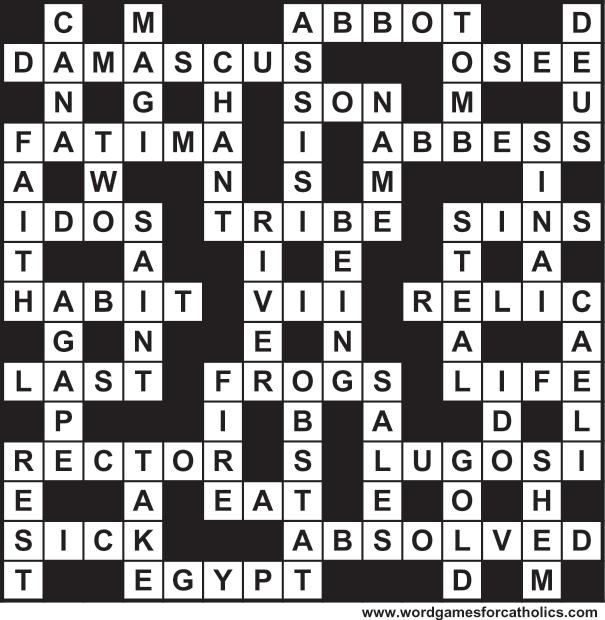
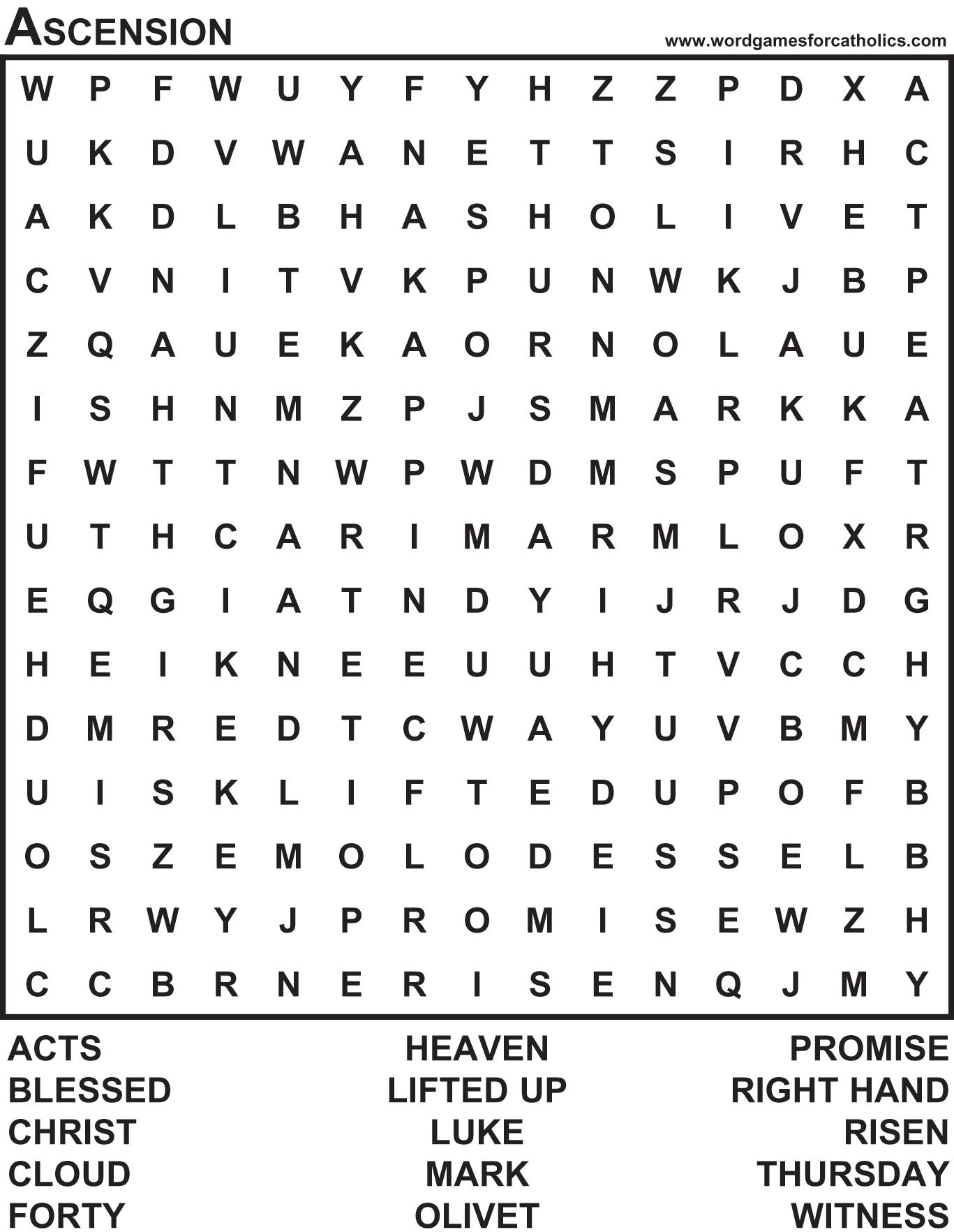
HOLIDAY ACCOMMODATION
ESPERANCE 3 bedroom house f/ furnished. Ph: 08 9076 5083.
GUADALUPE HILL TRIGG
www.beachhouseperth.com
Ph: 0400 292 100.
HOUSE TO SHARE for clean living male, $120p/w Riverton. Ph: 0449 651 697.
LARGE GOSNELLS 3 B/R UNIT to rent. Enclosed patio, easy care garden, large living area. Negotiable partly or fully furnished. Walk to Catholic primary and church. Commencing April $300 per week. Phone 0421 026 422.
MATURE WOMAN SEEKS SINGLE tenancy $150pw, S Suburbs. POLCL. 0448 938 348
AVAILABLE IN NORTH PERTH AND NORTH BEACH. Rent negotiable according to circumstances. Enquiries to phone 08 94488109
BRICK RE-POINTING Ph: Nigel 9242 2952.
PERROTT PAINTING Pty Ltd For all your residential, commercial painting requirements. Ph: Tom Perrott 9444 1200.
PICASSO PAINTING Top service.
Ph: 0419 915 836, fax 9345 0505.
PSYCHOLOGY and PSYCHOTHERAPY www.peterwatt.com.au Ph: 9203 5278.
BRENDON HANDYMAN
SERVICES Home, building main-
Deadline: 11am Monday
tenance, repairs and renovations.
NOR. Ph 0427 539 588.
MASSAGE BY QUAL. LADY for neck, back & sciatic. 22 years experience. Ph 9334 4409
FOR SNR/COUPLE who would like free holiday 2 weeks, May, to look after my dog? 9534 5150
ALL AREAS Mike Murphy Ph: 0416 226 434.
VIDEOS - ASSORTMENT musical, documentary and nature, Dutch/German, 25 for $50. Phone 9277 6128.
LAWNS
WRR LAWN MOWING and Weed
Spraying. Get rid of Bindii & Jojo clovers. 9443 9243, or 0402 326 637, e-mail william.rao@iinet.net. au
RELIGIOUS PRODUCTS
CATHOLICS CORNER Retailer of Catholic products specialising in gifts, cards and apparel for Baptism, Communion and Confirmation. Ph: 9456 1777. Shop 12, 64-66 Bannister Road, Canning Vale. Open Mon-Sat.
OTTIMO Convenient city location for books, cds/dvds, cards, candles, statues, Bibles, medals and much more. Shop 108, Trinity Arcade (Terrace level), 671 Hay Street, Perth. Ph: 9322 4520. MonFri 9am-6pm.
$4.40 FOR FIRST 2 LINES of a classified ad
RICH HARVEST YOUR CHRISTIAN SHOP Looking for Bibles, CDs, books, cards, gifts, statues, Baptism/Communion apparel, religious vestments, etc? Visit us at 39 Hulme Court (off McCoy St), Myaree, Ph: 9329 9889 (after 10.30am Mon to Sat). We are here to serve.
KINLAR VESTMENTS
Quality hand-made and decorated vestments: Albs, Stoles, Chasubles, altar linen, banners etc. 12 Favenc Way, Padbury. By appointment only. Ph: Vicki 9402 1318 or 0409 114 093.
SETTLEMENTS
ARE you buying or selling real estate or a business? Why not ask Excel Settlements for a quote for your settlement. We offer reasonable fees, excellent service and no hidden costs. Ring Excel on 9481 4499 for a quote. Check our website on www.excelsettlements.com.
COMPANIONSHIP
LADY SENIOR 80’S SEEKS
COMPANIONSHIP 2 or 3 times per week for tea and coffee, chat for an hour or two in Woodlands. Offer $5. Ph 0418 841 757 afternoon.
BOOK BINDING
BOOK REPAIR SERVICE
New Book Binding, General Book Repairs, Rebinding, New Ribbons; Old Leather Bindings Restored. Tydewi Bindery 9377 0005.
THANKSGIVING
Thank you St Jude for prayers answered. Alison
Please write one word per space/if you need more space attach paper
This advertisement to be included in the next issue of The Record and for ......... weeks after DEADLINE: Monday, 11am.
Post to Attention Record Classifieds, 587 Newcastle St, West Perth WA 6005
Fax to Attention Record Classifieds, 9227 7087
Phone Bibiana 9227 7080
COST: $4.40 for the first 8 words plus $1.10 per 4 words thereafter. GST inc.
24
3:14-20.24-25.28 God will save us Vio Dan 3:52-56 Glory and praise Jn 8:31-42 Son’s place assured
25 Th THE ANNUNICATION OF THE LORD (SOLEMNITY)
Wh Isa 7:10-14;8:10 God is with us Ps 39:7-11 An open ear Heb 10:4-10 To obey your will Lk 1:2-2-38 Mary disturbed
26 F Jer 20:10-13 Denounce him!
Vio Ps 17:2-7 God heard my voice Jn 10:31-42 You claim to be God
27 S Ezek 37:21-28 I will be their God Vio Jer 31:10-13 Like a shepherd Jn 11:45-56 Gather in unity
Former Dean of Parramatta Cathedral reflects the hidden significance of the 4 March Installation of Anthony Fisher OP as Bishop of Parramatta
BY FR JOHN BOYLE Parish Priest Castle Hill, ParramattaOn St Patrick’s Day, 1836, the newly-arrived Archbishop of Sydney, John Bede Polding, visited Parramatta to lay the foundation stone of a new church to be named after St Patrick. People from the town, from the Hills District and further West were in attendance. So were all the Catholic clergy of the colony.
The locals had never seen anything like it. Archbishop Polding was richly vested in rochet, stole and cope, with mitre and crozier; the clergy wore chasubles of silk, gold and embroidery work; even the chantors had copes of costly material.
On Thursday night (4 March), this scene was repeated on that same site, but for Bishop Anthony Fisher’s Installation there were two Cardinals, 35 Archbishops and Bishops and about 300 priests present.
It was the anniversary of Archbishop Polding’s ordination, so it was fitting that the installation of the third Bishop of Parramatta took place on that date and on a site sacred to Catholics for over 200 years and one visited often by the first Bishop in Australia.
Amongst the 2,000 lay people present for the two and a half hour ceremony, were the Premier, Kristina Keneally, both our Federal and State Members of Parliament and our two official parish representatives, Monica Guy and Michael Wilson.
I noticed that Peter Grace was in charge of the girls welcoming us to OLMC. The girls’ hospitality was warm and genuine. The Knights and Dames of the Order of Malta added a splash of colour to the Cathedral ceremony.
The music will be remembered and talked about. It was beautiful. It was executed with precision and passion. The choirs must have had intense preparation to master so many pieces of music, many of which were in Latin.
The Installation was a special occasion and demanded grand music, but some music was unsuitable for liturgical use and would have been best left in the concert hall. Music is so integral to Catholic liturgy and is often the cause of complaints and criticism.
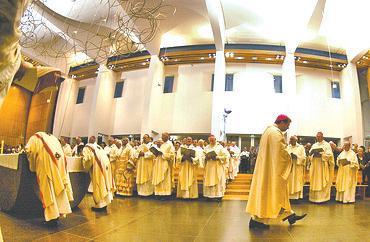

I would value the choirs coming together again to repeat Thursday’s performance before a more appreciative audience willingly there for the sole purpose of enjoying such rich fare.
There were problems with the sound system and some parts of the ceremony lacked organisation.
The most moving part of the ceremony for me was to see Bishop Fisher’s mother and father bring up the offertory gifts.
The newly-installed Bishop kissed his
mother as he took the gifts from her hand. Forty-nine years ago she had given him the precious gift of life and now she gave him the equally precious faith-gift that would become the Body of Christ.
It took all of three seconds but was a powerful sign of a bond symbolising the interconnection between family and faith.
The homily was what we wanted to hear. There was humour, for instance, when Bishop Fisher told us about the first Dominican to work in the colony, Fr Christopher Dowling.
He was Irish and arrived in Sydney in 1831. He was, or should have been, Fr Therry’s clerical superior. The Dominican, preaching on fraternal charity, made strong allusions to Fr Therry, who in the heat of momentary excitement dragged Fr Dowling from the altar.
Then, when Fr Therry went to the church door, still in mass vestments, with a collection box (perhaps a custom I could myself adopt if it helps increase the collections), Fr Dowling decided to challenge him and tried to wrestle the collection box from Fr Therry.
The congregation witnessed the two priests, both in mass vestments, fighting over the collection box.
The Dominican fled firstly to Windsor and then to Newcastle. Bishop Fisher made the comment that he hoped he wouldn’t suffer the same fate as his confrere and be forced to flee the area as the Dominican who proceeded him had had to do in 1838.
Bishop Fisher spoke for 23 minutes, and it was a well-delivered and meaty homily. He is a good speaker. I gave him 12 out of 10.
According to Tess Livingstone writing in The Australian, Bishop Fisher is “one of the Church’s colourful characters. An avid reader, skilled cook and internationally respected academic, he took a path less travelled to the priesthood”.
“He studied arts/law at Sydney University, was a solicitor for Clayton Utz in Sydney and had a serious girlfriend or two. He joined the Dominicans at 25, and was ordained six years later,” the journalist said.
“He completed a PhD in bioethics at Oxford before becoming a lecturer at the Australian Catholic University and the inaugural director of the John Paul II Institute for Marriage and the Family in Melbourne. Bishop Fisher is Australia’s youngest Catholic Bishop.”
Being a young Bishop means he is also one of the youngest priests in our diocese. It is a sobering thought that he will preside at my funeral, for he will be, in theory, our Bishop for 25 years. My prediction is that we will have him for six years or so and then, depending on the Cardinal’s health, he will move to Sydney. He is very talented.
I know he will have our support and we will keep him in our prayers.
He has an enormous task ahead of him and he mentioned some of the areas he will single out as priorities in his homily last Thursday night. He is the leader of the most Catholic diocese in Australia.
He should know he has the biggest parish in the diocese right behind him. I look forward to the day he makes an official visit to our parish to meet his loyal supporters.
Serious social issues of Fisher’s new diocese will groom him for Cardinal duties
NEWLY installed Bishop
Anthony Fisher OP of Parramatta has “huge social issues” to deal with in the western suburbs area that will test his suitability for being the next Cardinal of Sydney, the former Dean of the diocese’s Cathedral told The Record
Fr John Boyle, Dean of St Patrick’s Cathedral from 19902000, during which time it burned down in 1996, said last week that Parramatta, more so than Sydney, which has more resources, struggles with many social problems, including marital breakdown and welfare dependency.
While conceding that his own parish of St Bernadette’s in Castle Hill is a “rich parish”, Fr Boyle said Bishop Fisher would have the responsibility of assessing priori-
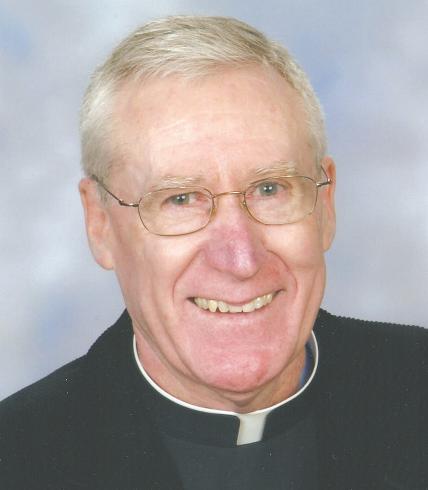
ties of fund allocation that will particularly affect the suburbs in the western parts of the diocese. His own parish’s St Vincent de Paul group doesn’t even focus in its own area but on the western suburbs where there are “massive problems” as migrants struggle with establishing themselves with little knowledge of English, and schooling “can’t keep up with the demand”.
“There are huge social issues that are much more prominent than Sydney, which is better
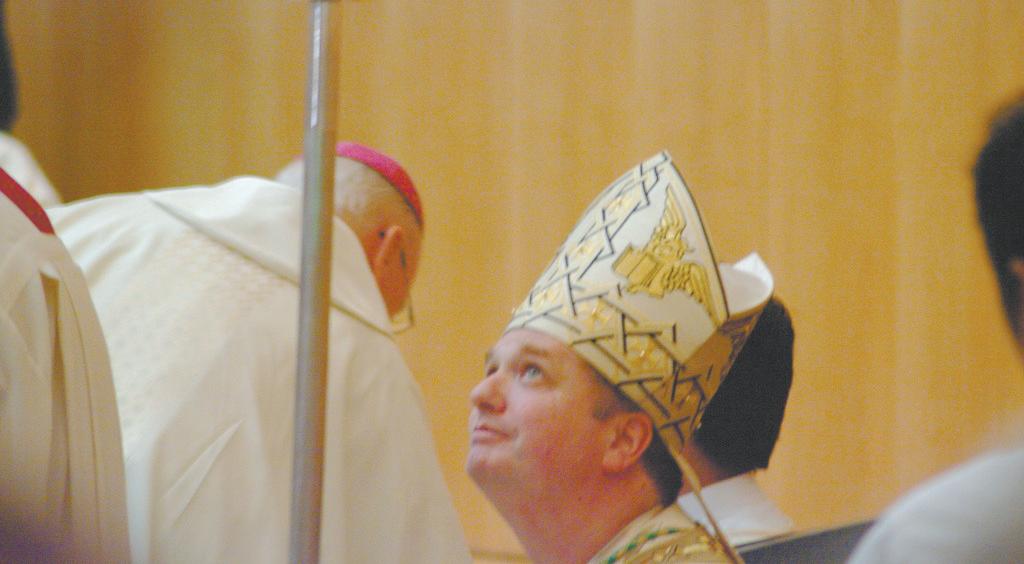
established and has more money at its disposal to fix those social ills, whereas our people are strugglers,” said Fr Boyle, a chaplain at the Richmond RAAF base who has been a priest for 38 years. For some, it’s a handout existence; welfare agencies are in big demand.”
“It’ll be interesting to see how (Bishop Fisher) goes out there, as that really is a challenge. When our priests are sent out there, they’re not really happy about going, but then they end up lov-
ing it and don’t want to leave, as the people out there are salt of the earth, and are extremely appreciative of the assistance and personal contact made by priests.”
“We have a significant unemployment issue we struggle with, and we have the biggest concentration of Catholic Aborigines. The diocese helps them in very practical ways.”
Fr Boyle, 64, who has been parish priest at Castle Hill for four years, was particularly impressed by Bishop Fisher’s sincere state-
ment that he had a special concern for the priests of his diocese.
“That’s not always perhaps to the fore of Bishops’ priorities; sometimes they’re not focused on care for priests and sometimes we feel disenfranchised, not marginalised, and here is our new Bishop saying one of the core cares he will have is to look after his priests,” Fr Boyle said.
“That’s impressive – we have old and young guys who need looking after. He has a sense of humour; I like that too.”
Fr Boyle also stated in his parish bulletin of 6-7 March that he predicts Bishop Fisher will only be in charge of Parramatta for about six years, “depending on (Cardinal George Pell’s) heath” before becoming the next Cardinal of Sydney.
“He’s clearly meant for great things,” Fr Boyle told The Record “He’ll go to Sydney (as Cardinal) as he’s bright, on the ball, young … they’re blooding him in the diocese in the west - which won’t be easy for him - to see how he goes. If he makes a success of that then he’ll go on to higher things, so we’ll educate him … for the rest of the Church.”